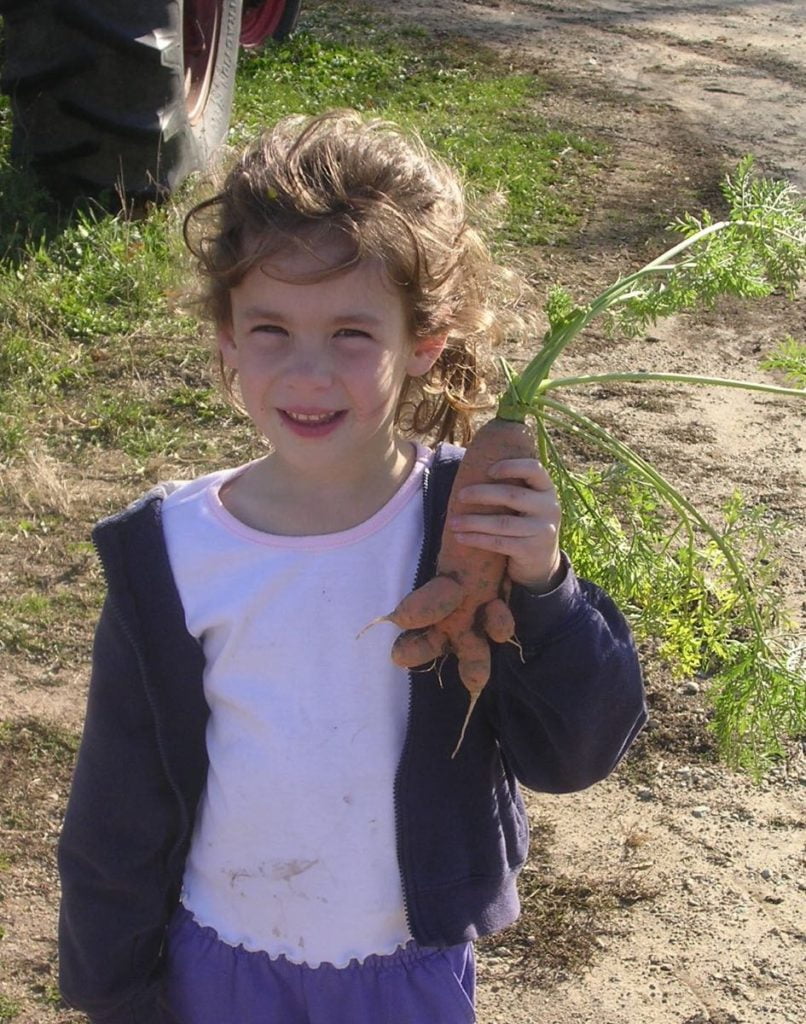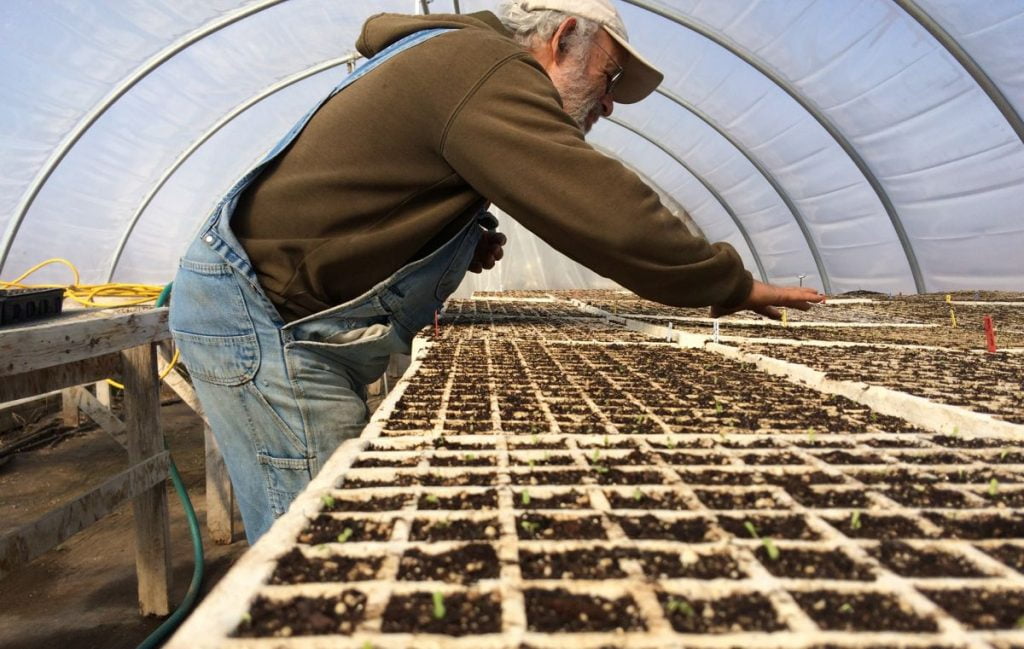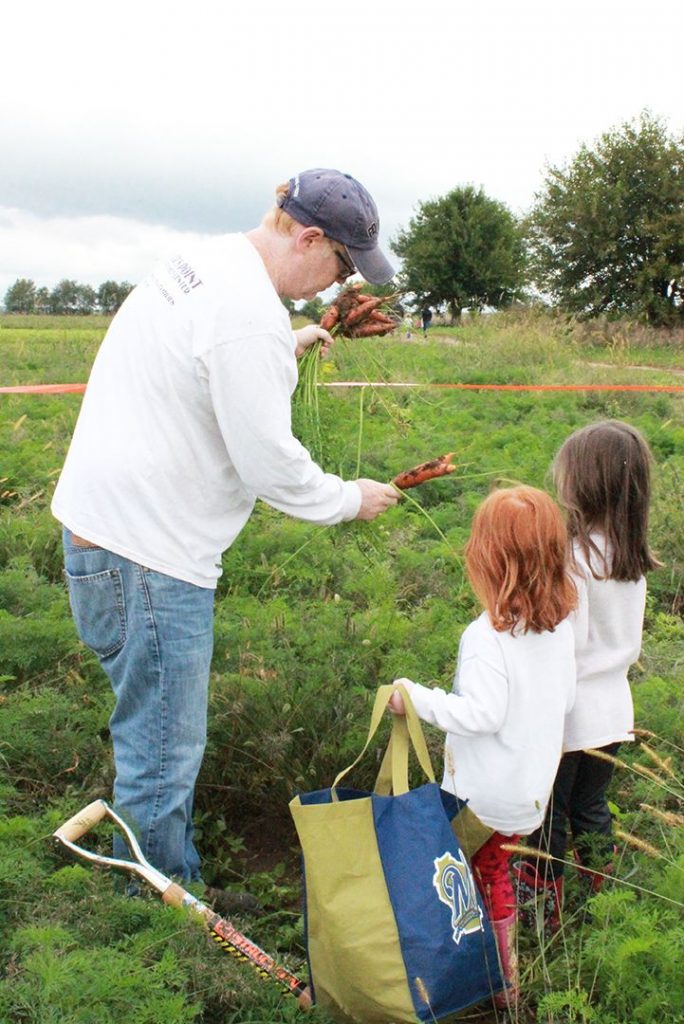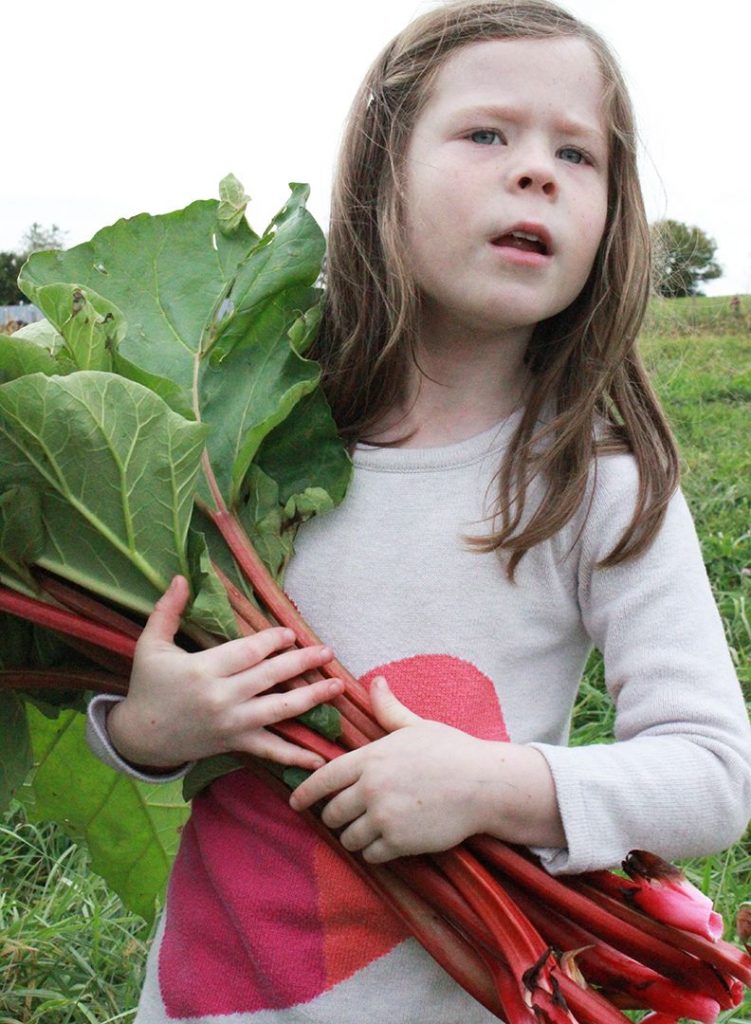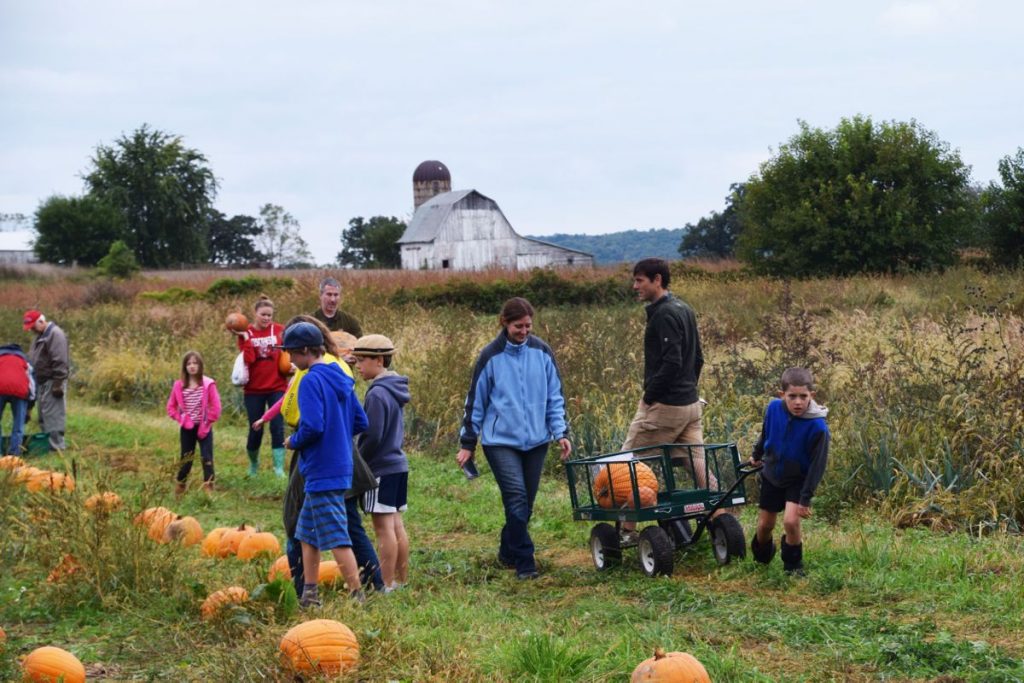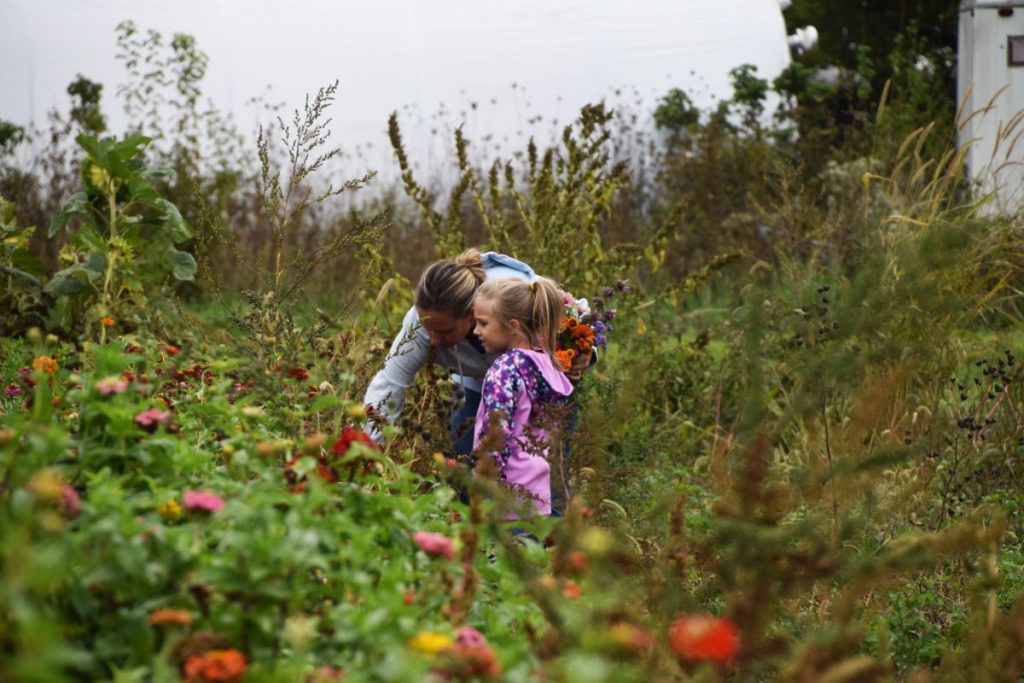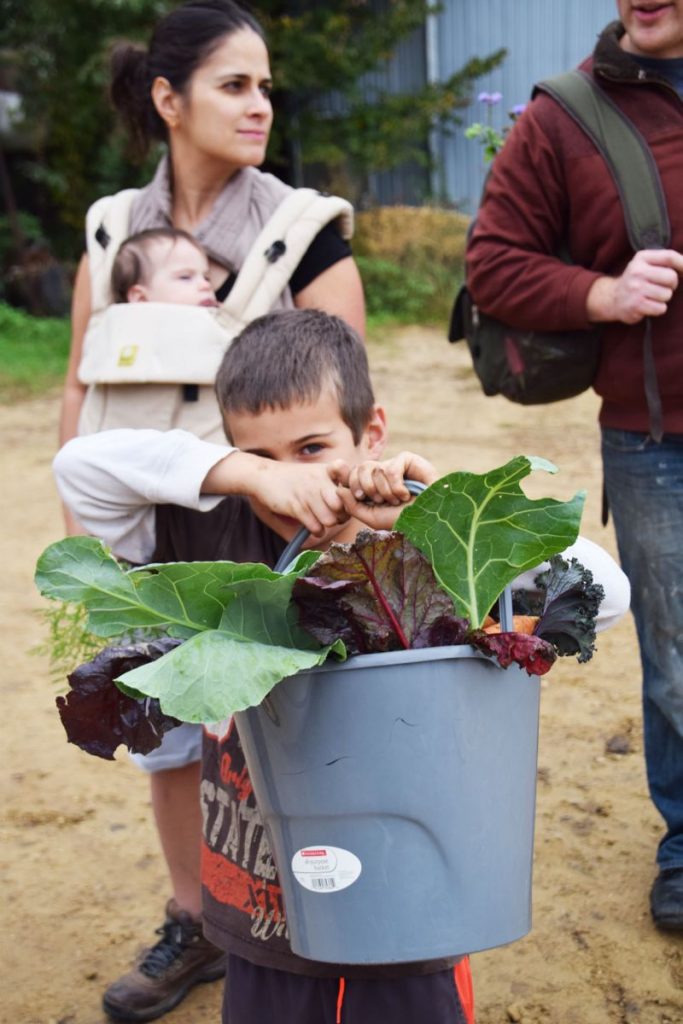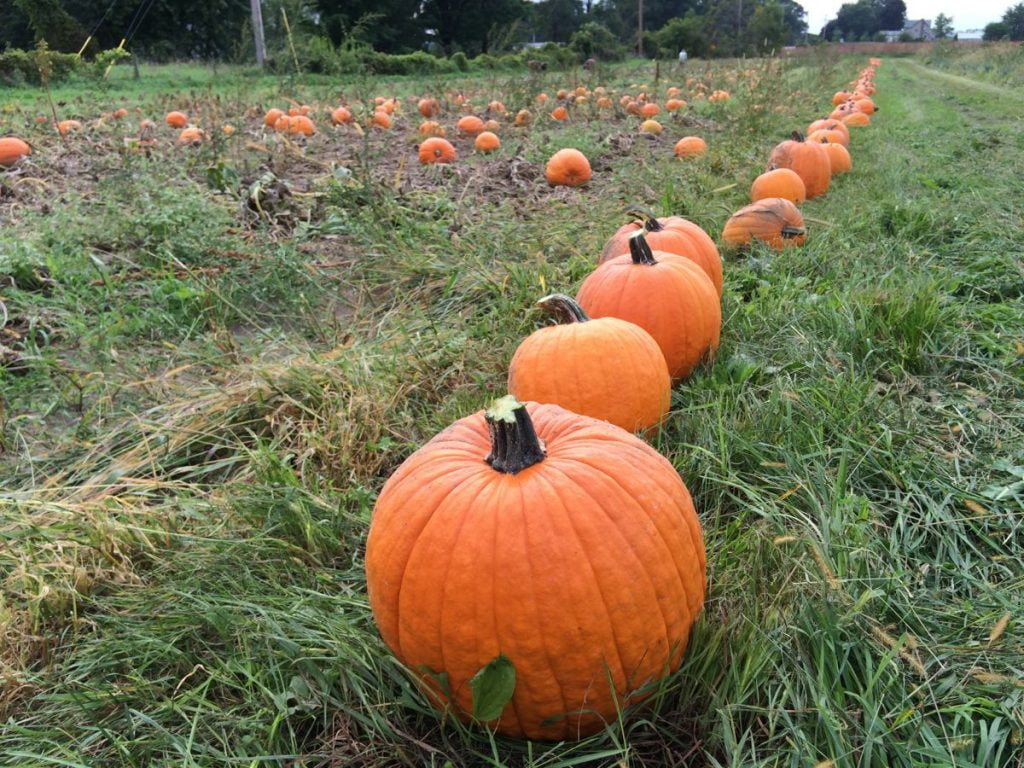Blog
Week #2, HS graduation
- On: May 24, 2017
 0
0
Our daughter Sophie graduates from high school this week as valedictorian of her class. This isn’t exactly farm news, but is a big part of our lives right now. We are so proud of how hard she has worked. In fall, she heads to Macalester College in Saint Paul to study math and studio art. Our families are coming to visit so we are hosting a grad party this weekend. The low point of the party preparations came a few days ago, when a skunk sprayed in our garage. The scent is fading but is still very, very recognizable. The high point has been gathering Sophie’s prolific artwork to display all over our house. Anyway, we will be busy this weekend. I will watch for emails but might be slow to respond. Thank you in advance for your patience. Beth

Beth, Sophie and Steve on academic awards night, with all of Sophie’s academic swag.
Recipe Log
Over the winter, some of you asked for better organization to review recipes from previous weeks of the current season. This is a good idea. The vegetables often overlap from week-to-week so the previous week’s recipes can be quite useful. I’ve started a webpage to collect the recipes. Go to our 2017 Recipe Log. I’ll try to keep it updated each week, although that might not happen until Friday each week.
Veggie List and Veggie Notes
Heads up. It has rained a lot this week. Rain splashes soil and grit into your asparagus, lettuce and spinach. These vegetables will need extra attention and washing this week. This phenomena goes hand-in-hand with eating locally. Lettuce grown in the desert in California is never exposed to rain! Right now, we’d be glad to farm in a desert. We are impatient for the end of this rainy spell.
Asparagus, 0.85 lb
Button mushrooms, 12 oz
Spinach, 1 bunch, 1 lb or more
Romaine lettuce
White salad turnips, 1 bunch
Radishes, 1 bunch
Arugula, 1 bunch
Green garlic, 1 bunch
Rhubarb, 1.75 lb
Next week’s box will probably contain asparagus, spinach, lettuce, escarole, scallions and more.
Asparagus, lettuce, spinach, green garlic, rhubarb – Check last week’s newsletter for prep and storage information. I provide a crop overview the first time we deliver each season. After that, I’ll provide weekly updates when needed.
Button mushrooms – These organic mushrooms are from Hidden Valley Mushrooms from Wisconsin Dells. We buy mushrooms from Mary every year; they are a great addition to spring salads and quiches. Here are Mary’s suggestions for storing the mushrooms. Store separate from leafy greens, which hasten mushroom aging. If storing for more than a few days, remove from the box and store in a paper bag with holes punched in the side. Keep dry. Don’t wash to clean, just wipe with a damp cloth.
Romaine lettuce (tall head of lettuce with crisp leaves) – More sturdy and less fragile than our other spring lettuces. Great for salads. To wash, slice crosswise into ribbons. Submerge in a pan or sink of water. Drain. Repeat. Expect to wash this Romaine several times. Dry it in a salad spinner and store in a dry container.
Arugula – (small bunch of green leaves with pungent scent) – Arugula is good mixed with lettuce or spinach in salads, or added to cooked dishes such as lasagne or quiche. I love it on sandwiches. This arugula is thin-leaved and tender and will not store for long. Eat soon. Cover and refrigerate.
White salad turnips (bunched white roots with green tops) – I know that returning members look forward to these sweet and delicious turnips, which taste nothing like the turnips that are harvested in fall.
– Storage: Cover and refrigerate.
– Uses: Both the turnip roots and tops are edible. Slice the sweet roots and add to salads. They can be cooked and are especially good when lightly sauteed in butter. Stir as little as possible so they brown on at least one side. The turnips greens are excellent cooked. Treat them like mustard greens.
– Our favorite use: Slice the roots very thinly and combine with a mixture of rice vinegar, mirin, soy sauce, sesame oil. Eat immediately or marinate.
Rhubarb – Rhubarb is easy to freeze because it does not need blanching. Slice, put in a container and freeze – that’s it.
LOCAL THYME RECIPES
Comforting Classics
Rhubarb Pudding Cake
Spinach and Mushroom Salad
Romaine Arugula Salad with Walnuts, Parmesan and Creamy Lemon Dressing
Chicken A la Maria (vegetarian option in recipe)
Outside the Box Recipes
Rhubarb-B-Q Sauce
Arugula Pesto-packed Lentil and Mushroom Balls
Ground Turkey, Mushroom and Radish “Macos”
Pappardelle Florentine
Quick and Easy Meal
Spicy Asian Noodles with Asparagus and Mushrooms
RECIPES FROM LAUREN
MUSHROOM & “LOTS OF GREENS’ SHEET PAN QUICHE
Inspired by Smitten Kitchen
Because this is a sheet pan quiche, it’s a little trickier to use store bought pie crust. I promise you that following the techniques below, you can make pie crust from scratch, but if you really don’t want to or don’t have the time, you could do this quiche in two store-bought frozen 9″ pie crusts. Trader Joe’s has really stellar frozen pie crust! You can also go crustless entirely and just make a delicious egg bake in a well-greased pan.
Takes 1 hour, 45 minutes†if making the crust from scratch (much of it inactive) or 45 minutes with store-bought (or no) crust
Serves 12-16
Pie Crust:
1 cup butter (2 sticks)
1 cup water
2-1/2 cups all-purpose flour
1 tablespoon sugar
1 teaspoon salt
Filling:
2 tablespoons butter
1 green garlic, white and pale green parts only, minced
12 ounces mushrooms, sliced
3 cups arugula, roughly chopped
3 cups spinach, roughly chopped
Turnip greens, roughly chopped
1/4 cup water
1 teaspoon Kosher salt
1/2 teaspoon freshly ground black pepper
1/4 teaspoon red pepper flakes
6 ounces cream cheese, softened
2/3 cups whole milk
6 large eggs
1 cup shredded cheddar cheese
1/2 cup finely grated parmesan
- Begin preparing your crust (if you plan to make it; if you don’t skip to step #8). Cut the butter into small cubes and place in the freezer until ready to use. Fill measuring cup with 1 cup cold water and place in the freezer.
- In a large bowl, combine flour, sugar and salt. Add butter and use your fingers to incorporate the butter into the flour. You will pinch the butter cubes into smaller pieces until they are about the size of peas and uniformly incorporated. Some pieces of butter will be small and some will be larger; that’s absolutely fine!
- Remove†the water from the freezer and pour in half. Use a rubber spatula to press the dough together. If it’s still dry (it likely will be) continue to add water until the dough comes together. You may need to knead with your hands a little bit.
- Wrap pie dough in plastic wrap and place in freezer for 20 minutes.
- Remove dough from the freezer and roll out to an approximately 12×16-inch rectangle. Carefully, fold it in half and then in half again. Move the dough to a 10×14-inch baking sheet and unfold. Press gently into pan. Remove any excess dough from the edges. Prick the crust with a fork and place pan in the freezer.
- Preheat the oven to 425 degrees and while you wait for it to preheat, begin slicing your mushrooms and chopping your greens!
- Once the oven is preheated, line your pie crust with foil and fill with pie weights (or dried beans or rice you don’t plan to cook). Bake for 20 minutes. Remove the foil and weights and bake 5 minutes longer. If using store-bought crust, follow package directions for pre-baking.
- While the crust bakes, melt the butter for the filling in a large, deep saute pan (the larger the better, you’re going to be throwing a lot of greens in here– if you don’t have a large saute pan use a soup kettle) over medium low heat. Add the green garlic and cook for a couple minutes until fragrant. Add mushrooms and saute until soft, about 10 minutes more. Add all the greens, water, salt, pepper and red pepper flakes to your pan. Saute until the greens are well wilted.
- In a large bowl, beat softened cream cheese with a wooden spoon until smooth. Add the milk and whisk until smooth. Add the eggs, two at a time, again whisking until smooth after each addition. Stir in sauteed mushrooms and greens along with the cheeses.
- Pour filling into the prepared, prebaked crust until filling is set, about 30 minutes.
.
MY FAVORITE ASPARAGUS SOUP
Adapted from 101 Cookbooks
This recipe calls for two ingredients you may not have in your pantry, but they are very simple to find and great to have on hand.
Coconut milk is one of my favorite ingredients. It can transform a pile of sauteed vegetables into a curry. It can replace dairy in a soup (as it does here). It can thicken mashed potatoes. I even put it in my coffee and oatmeal. There is both a full and reduced fat version of coconut milk available. I always get the full fat because it’s lower in sugar and adds a more robust flavor.
Green curry paste is another product I love for the bright, herbal flavor it adds to simple dishes. You don’t need much of it so it comes in a pretty small glass jar. You can find both of these items in the “ethnic or global” aisle of any grocery store in the Asian foods section. Thai Kitchen is a great brand for both products.
Takes 20 minutes
Serves 4
2 tablespoons butter or olive oil
2 green garlic, white and light green parts only, minced
1 bunch turnips, greens removed and diced
1 tablespoon green curry paste
1 pound asparagus, tough ends removed and cut into 1/2-inch pieces
1 14-ounce can full-fat coconut milk
1 teaspoon Kosher salt
1-1/2 cups water
1 lemon or lime
- In a large stock pot, melt butter or heat olive oil over medium heat and add green garlic. Cook until fragrant, a couple minutes. Add turnips and cook until completely tender, about 10 minutes. You can add a splash of water if the pan gets too dry.
- Stir in the curry paste and stir so it evenly coats the turnips. Allow it to cook for 2 minutes before adding asparagus, coconut milk, salt and water. Simmer gently for 5-10 minutes then puree with an immersion blender until smooth. If you don’t have an immersion blender, pour into a blender or a food processor.
- Squeeze in half of the lemon or lime into the soup, taste and adjust flavors as needed. If it’s too thick, add some water. If it’s too thin, simmer it gently for a few more minutes.
Welcome!
- On: May 17, 2017
 0
0
Welcome to our CSA! Deliveries begin this week for weekly members and for purple every-other-week (EOW) members. Green EOW, your first delivery is next week, May 25/26 (Thursday/Friday sites). Sampler share members, your deliveries begin June 1/2 (moon group) or June 15/16 (sun group). Go here to print the delivery calendar.
Things you need to know.
♦ On Thursday, we deliver CSA boxes to Evansville, Fitchburg, Madison, McFarland, Middleton and Oregon.
♦ On Friday, we deliver CSA boxes to Brookfield, Janesville, Mequon, Milwaukee, Waukesha and Wauwatosa.
♦ We post this newsletter/blog each Wednesday night, with the list of veggies for the week, quantities, information about storage and preparation, news of the farm, recipe list, and a forecast for the next week’s box. We alert you by email on Wednesday night once the newsletter is posted and ready to read.
♦ Want earlier notice of what will be in the box? Check the sidebar on our website homepage around 7 p.m. on Wednesday night. I’ll post the list under “Box Contents.” I also provide a tentative list for the following week in the Veggie List section of this newsletter. The next week’s list is rarely complete but the items listed are ones we feel confident about.
♦ EOW, sampler and weekly members, we assume you read all the newsletters, even on your “off” weeks. This newsletter (and our emails to you) are our means to communicate with you.
♦ The first few boxes of the season are often the lightest. EOW members, do not worry that you have signed up for the wrong share. Our deliveries get heavier and more abundant as the season progresses.
♦ We will sometimes write “OR” in the produce list, e.g. green leaf OR red bibb lettuce. You will receive one of these crops. All the boxes at each site are identical; we pack the same crops for all the members at each site. Please don’t open other members’ boxes.
Up and Running
Whew, it’s a relief to have our first CSA box almost complete. Soon the produce will be in your hands and you can take over. Our farmhands are back to work after a winter furlough. Steve says we have 10% of our fields planted. We are off to a good start Let’s share a few spring moments.
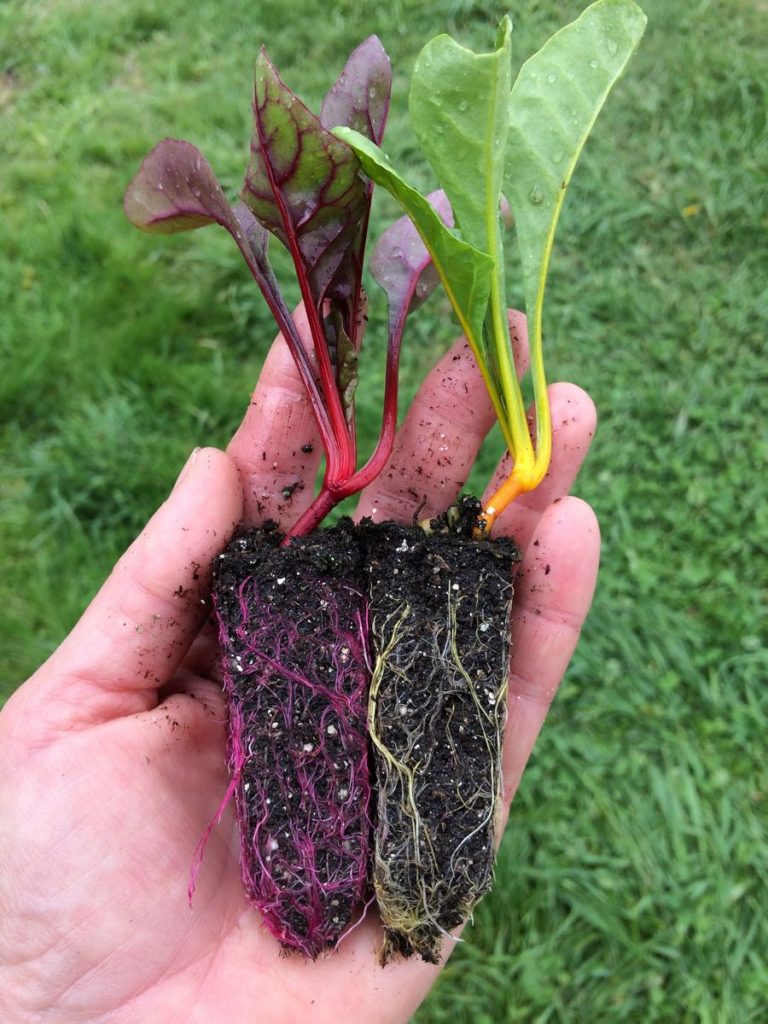
Look what we discovered when transplanting our Swiss chard seedlings. Chard roots are often tinged with color but none of us remember roots this vivid. That’s a red chard seedling on the left and a yellow chard seedling on the right.
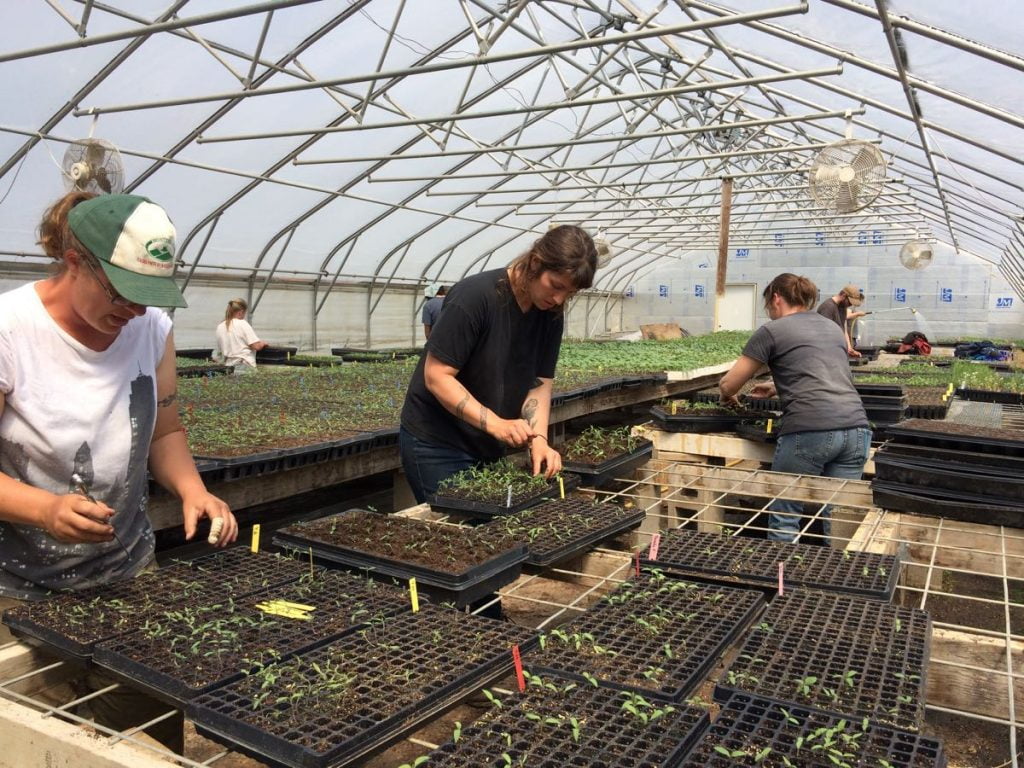
Many spring projects are group efforts. From left, Kristin, Simone, Smitty (in back), Charlotte, Karen, Jim and Kelsie repotting tiny pepper seedlings into bigger pots. We start the seeds in small plug trays to save greenhouse space in early spring when it’s costly to heat the greenhouses. Soon we can turn the heaters off. The transplanting job is a favorite; the work is social and the greenhouse is warm and cozy on sunny days.
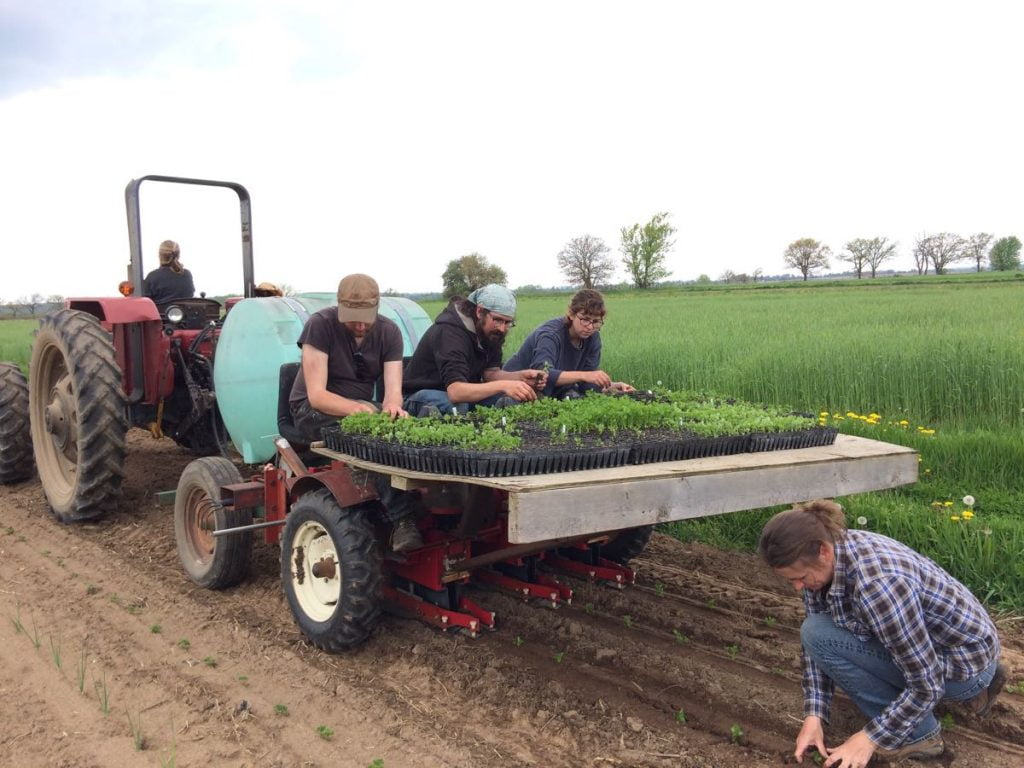
Whenever possible, we prefer to nurture seedlings in the greenhouse then transplant them outdoors once big enough. It’s a great system for slow-growing seedlings like the celeriac being transplanted in the photo above. Simone drives the tractor. Jim, Smitty and Kelsie drop seedlings into the transplanter cups. Karen double-checks planting depth. Lush cover crops ripple in the background.
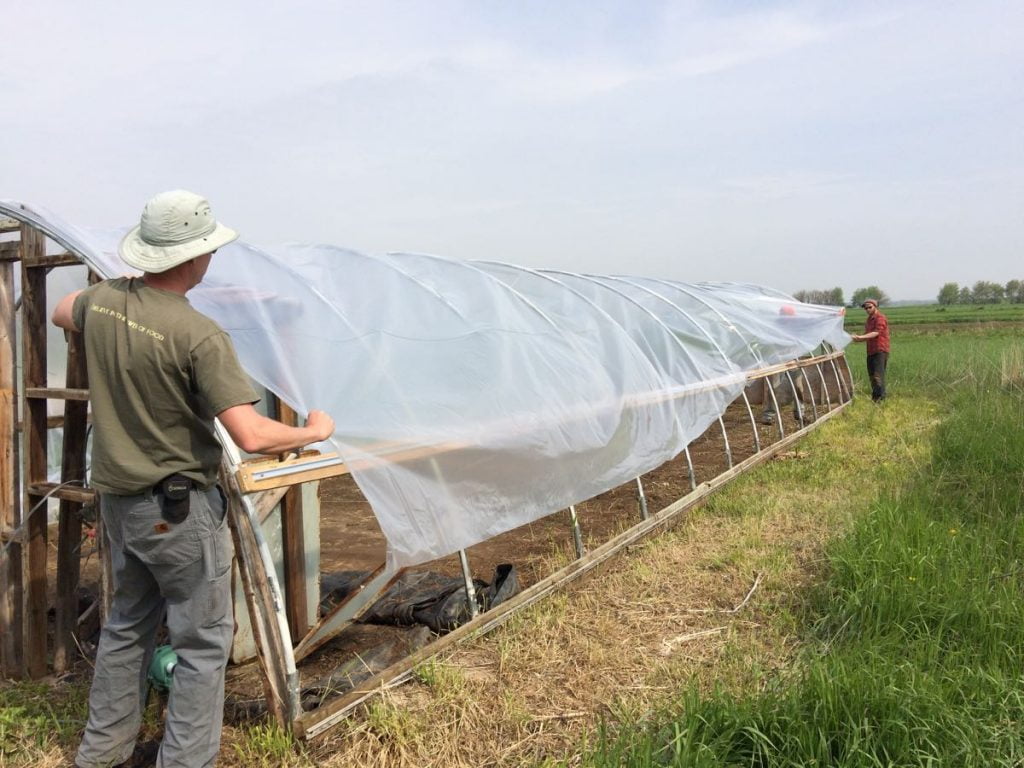
Matt and Kristin replace the plastic on one of our smaller greenhouses where we will grow celery this summer. This is a new experiment but we’ve read that it’s a good way to grow high-quality celery.
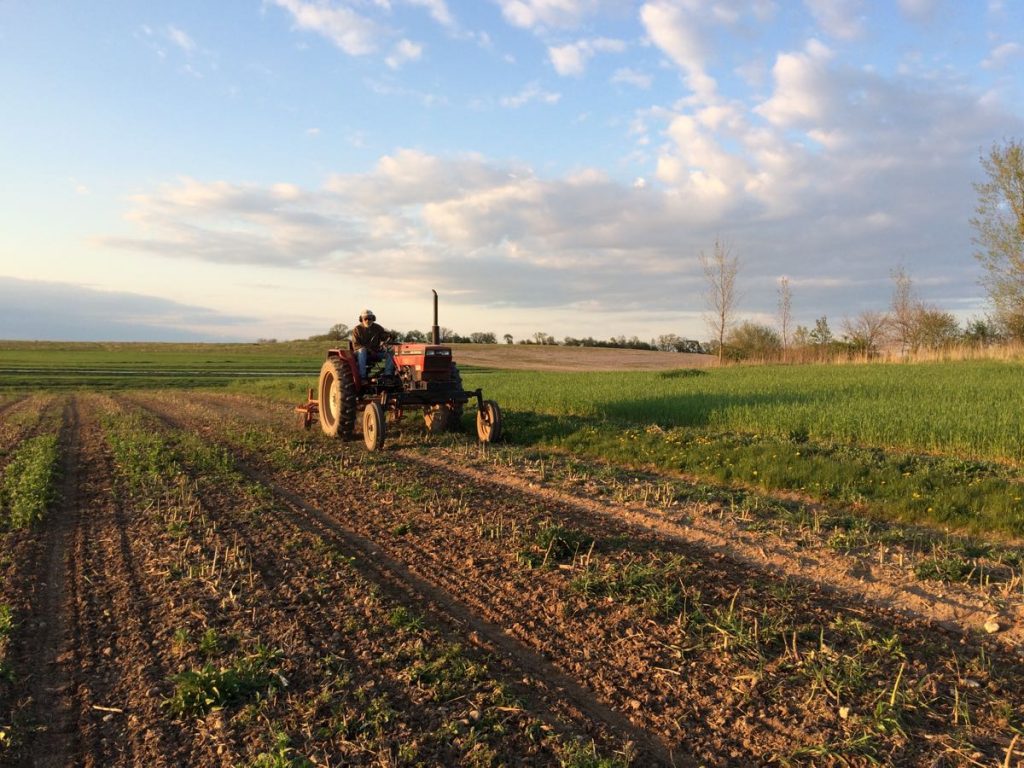
Steve enjoys a quiet moment cultivating the asparagus field.
Veggie List and Veggie Notes (May 18/19, 2017, week #1, purple EOW)
Read this section each week for specific information about the produce. For example, see our notes below about how to extend the storage life of your lettuce and spinach. I provide detailed notes on each crop only the first week we pack it. This is another reason to read our newsletter each week.
Asparagus, 1 lb
Oneida Gold potatoes, 3.5 lb
Spinach, 1 bunch
Bok choy
Red leaf lettuce
Salad radishes, 1 bunch
Green garlic, 1 bunch
Rhubarb, 2 lb
Next week’s box will probably contain asparagus, rhubarb, mushrooms, lettuce, spinach, radishes, green garlic and more. Watch next week’s newsletter for the final list.
Asparagus – Enjoy this spring treat! Your asparagus will be green or purple. The purple variety turns dark green when cooked. Its flavor is almost identical to normal green asparagus. Wash your asparagus thoroughly to remove hidden grit. Submerge in water, soak briefly, then swish vigorously and pull out of the water with the tips pointing down. The draining action helps pull the grit out of the asparagus tips. Repeat several times.
Storage: Asparagus is perishable, so eat it as soon as possible. Store it in the paper bag we packed it in, and wrap loosely in a plastic bag. The paper bag protects the asparagus tips from direct contact with the plastic bag. The plastic bag keeps the asparagus from wilting.
Preparation: We snap our asparagus at harvest, rather than cutting. Therefore, there is no need to snap the stalks to remove fibrous ends. For the same reason, it is not necessary to peel the asparagus stalks. It’s OK to trim the end a bit.
Cooking: If your asparagus stalks vary greatly in size, you will want to cook the thicker ones longer. Put the asparagus in a steamer pot over water. Alternatively, you can lay spears flat in the bottom of a broad pan, with ½ inch of water. Cover and steam over medium heat until just tender. Use two forks or a spatula to turn the asparagus during cooking, rotating the bottom spears to the top. Drain and serve. Also excellent broiled or grilled. Good dressed with vinaigrette, or simply with lime juice, salt and pepper.
Oneida Gold potatoes – Please refrigerate these potatoes. They are in great shape now but will sprout within days if stored at room temperature. They’ve been stored all winter and want to grow. Store in a paper bag to protect from light, even in the fridge. We grow everything we send in our CSA boxes except potatoes, some of the garlic, and mushrooms, all of which we buy from organic growers that we trust. We purchased these potatoes from Jesse Perkins at Vermont Valley Farm. This is a new variety for all of us. Jesse says “It is a very good all-purpose potato. They are very good eating.” He also says the potatoes have a higher sugar content because of starch to sugar conversion during cold storage. The potatoes taste a bit sweet, and will blacken slightly when fried. It’s a harmless color change due to the sugar conversion.
Lettuce and spinach – Wash your greens to remove grit splashed into the heads by rain. Cut to the size you like, submerge in water, swish gently, then pull from the water and drain in a colander. Some weeks, you will need to repeat in fresh water.
Storage hint – To extend the storage life of your tender greens, wash them, dry in a salad spinner, then store in a dry container or bag. Lettuce and spinach last much longer when handled this way.
Bok choy (large rosette with thick white stems and green leaves) – This Asian green is good for stir-frying or sautéing or in soup. You can think of the stems and leaves as two separate vegetables. The stems require longer cooking. The leaves will cook almost as quickly as spinach. Bok choy stores well, so feel free to pull off leaves as you need them, or use the whole head at once. Refrigerate in a plastic bag.
Green garlic (looks like scallions, tastes like garlic) – Last fall, we planted garlic cloves that grew into the stalks we harvested this week. If left to grow until mid-summer, the slim white bulb on this week’s garlic would divide and form the usual cluster of cloves in a garlic bulb. This year’s green garlic is robust. I’ll write more about that next week; t’s the result of a few years’ effort.
Preparation: Green garlic is more pungent than scallions, so slice thinly and use sparingly when raw. It mellows when cooked. Chop and add to any cooked dish that would benefit from garlic. Use the white bulbs and pale green stems. Avoid the dark green stems and leaves, as these are fibrous.
Rhubarb – Refrigerate in a plastic bag. FYI, 2 lb of rhubarb yields 6 – 6.5 cups when chopped.
Stewed rhubarb: This is the simplest way to prepare rhubarb. Chop rhubarb into one inch chunks. Stir over medium heat with a small amount of water in the bottom of the pan. The rhubarb will release moisture as it cooks. Stew until it softens and falls apart. Sweeten to taste with honey or sugar. Eat warm on its own, over vanilla ice cream, on pancakes, etc.
Recipes from chef Pat Mulvey at Local Thyme
Comforting Classics
Asparagus and Spinach Risotto
Rhubarb Preserves
Hot Pot with Tofu, Noodles, Bok Choy and Radish
Patatas Bravas with Smoked Paprika Aioli
Outside the Box Recipes
Potato and Asparagus Soup with Lemon Butter Braised Asparagus Tips
Rhubarb Baked Beans
Grilled Chicken or Tofu and Spring Vegetables
Potato, Spinach and Sausage (or Mushroom) Frittata with Parmesan
Quick and Easy Meal
Warm Asparagus, Potato and Egg Salad
Recipes from Lauren
SPRING DREAM SALAD with PICKLED RHUBARB & CANDIED WALNUTS
Just the greens, radishes, walnuts and pickled rhubarb with the creamy honey dressing is plenty to make your lunchbox sing, but I love to toss in some avocado for added creaminess and a little extra heft. If you don’t have one on hand or don’t feel like buying the very non-local ingredient, feta cheese makes a great substitution.
Serves 2-4 as a meal or 6-8 as a side dish
Takes 30 minutes (though rhubarb is best if made the day ahead so it can chill)
2/3 cup walnuts, halved or chopped
1/4 teaspoon Kosher salt
1/4 teaspoon cayenne pepper, optional
2 tablespoons honey
1/2 bunch spinach, roughly chopped
1 head lettuce, roughly chopped
1 bunch radishes, sliced
1 avocado, sliced in half, core removed and sliced, optional
Pickled Rhubarb:
1/2 cup apple cider vinegar
1/2 cup water
1/2 cup sugar
1/4 teaspoon Kosher salt
1/4 teaspoon black peppercorns
1/4 teaspoon cardamom
5 cloves
1/2 pound rhubarb, ends trimmed, cut into 1-inch piece
Honey Vinaigrette:
6 tablespoons olive oil
2 tablespoons apple cider vinegar
2 tablespoons honey
1 teaspoon mustard (I use stone-ground but Dijon will work well too)
1/4 teaspoon Kosher salt
Freshly ground black pepper
- Prepare the pickled rhubarb first so it has time to cool. It’s even better if you can make the pickled rhubarb a day in advance. Bring vinegar, water, sugar and salt to a boil in a small saucepan.
- While waiting, pack a pint-sized mason jar with black pepper, cardamom and cloves followed by rhubarb. Once the pickling mixture is boiling, pour it over the rhubarb. Seal and allow to cool before putting in the fridge to chill. Will store in the fridge for several weeks.
- In a large skillet, toast walnuts over medium heat for five minutes. Add salt, cayenne and honey. Cook 3-5 minutes longer until well toasted and honey just starts to turn a darker shade of brown. Pour out on a piece of wax paper or parchment to cool and prevent clumping.
- Whisk vinaigrette ingredients together in a small bowl until smooth and even. The mustard will help your dressing emulsify and stay together.
- Strain pickled rhubarb (or as much as you plan to use).
- Prepare salads by tossing spinach and lettuce together in individual bowls. Add pickled rhubarb, candied walnuts, avocado or feta, if using, and top with sliced radishes.
- Enjoy the healthy spring welcome!
.
MASHED POTATO FRITTERS
Serves 4
Takes 30 minutes (more if you have to make mashed potatoes first)
2 cups leftover mashed potatoes, cold is fine (actually it’s better)
1/2 bunch spinach, finely chopped
2 teaspoons minced green garlic
1/2 cup breadcrumbs
2 eggs, divided
1/2 teaspoon Kosher salt
1/4 teaspoon freshly ground black pepper
2-4 tablespoon vegetable oil, divided
- Combine leftover mashed potatoes, spinach, garlic, breadcrumbs, 2 eggs, salt and†pepper together in a large bowl until well-mixed. The batter will be pretty wet.
- In a large skillet (preferably cast-iron or something that can go in the oven), heat 2 tablespoons of oil over medium heat until it glistens. Add a 1/4 cup of batter (it can be heaping) into 4 piles with some room between them. You don’t want them to be crowded so if you can’t fit the 4 then just do a few more batches.
- Reduce heat to medium low and cook until the bottom of the fritter is golden brown, 3-4 minutes. Flip gently and then press down with your spatula to make a pancake. Cook another 4-5 minutes until golden brown and cooked through. Place on a paper towel, add remaining vegetable oil to pan (if you need it) and repeat with remaining batter.
- I love to serve these with eggs on top, a side of bacon and roasted asparagus. Sometimes we even get fancy and make hollandaise sauce on a lazy Sunday. That’s truly the best and what I’ll be serving up for a belated Mother’s Day feast!
Spring Forth
- On: April 04, 2017
 0
0
We still have CSA shares available.
Returning Tipi members, go here to register.
New members, go here to register.
Survey Results
I promised to share the results of our end-of-season survey. Participation was terrific – over 50% of households responded. Thank you for participating! Here’s what you told us.
The Good News
The two questions below are important benchmarks for us. We found high satisfaction with the amount and value of produce we packed for you.
Did we send the right amount of produce? Look at the chart above and you’ll see that the results could not be more balanced. 13% said they could have eaten more produce and 12% would have preferred less each week. With our existing structure (one size box per week), I do not think we could do much better. These results mask a lot of individuality, from weekly to every-other-week shares, from single households to multiple families splitting a share. We conclude that most of you have found ways to make the deliveries work.

Do you feel you’ve received a fair value for the cost? This is an important question and we’re very happy with the result. Averaged over the season, our weekly boxes contain extra value over purchasing the same organic produce at Willy Street or Outpost Coops. It’s part of our commitment to taking care of you. We are glad you recognize the value packed in those boxes.
The Other Good News
We polled you about the crops you want MORE of and the ones you want LESS of. Fortunately, the strongest responses were all for crops that behaved poorly in last year’s wet weather. Given a normal year, we will return to typical amounts of these crops.
- LESS bell peppers. This is the only thing you clearly asked for less of! Yes, we did sent more bell peppers than usual last season. It was a good pepper year, at a time when some other crops failed. We were generous with peppers because we had fewer options to feed you. Peppers remain a very popular crop with CSA members, so I won’t reduce them needlessly. However, I won’t go overboard again this year. Those of you who froze your excess peppers last summer tell us you enjoyed them this winter.
- MORE Brussels sprouts, MORE cauliflower, MORE winter squash. Yes, these all did terribly last year because of the wet weather in late summer and fall. Should bounce back this year. We’ve trialled new winter squash varieties over the last few years, and have a few new ones for this season.
- MORE lettuce later in the summer, to go with the tomatoes and other salad ingredients. Mid-summer lettuce is tricky but we’ve identified a few varieties that do well for us. Heads will be smaller than the spring lettuce, but that’s a good thing in summer when the boxes are so full.
- MORE spinach, later in the season. We attempt fall spinach year-after-year and it fails. We have a few ideas to try. Who knows? This could be the year we crack this nut.
- MORE strawberries, sweet corn and sweet potatoes. I’m sorry but we’re at the maximum we can produce (and pick!) of these crops. We might be able to add another sweet potato delivery. The Extension and Storage shares are likely to have sweet potatoes, so those are good options for sweet potato fans.
We can do these.
Here are changes planned in response to your requests.
- Some of you asked for earlier notice of what will be in the box. I will post the box contents in the sidebar of our website at 7:00 pm on Wednesday night. That’s a few hours earlier than you receive my weekly email. Also, check our weekly newsletter for the next week’s forecast. It’s not a complete list; it’s just the items we are confident will be ready to harvest the next week. The forecast is listed at the bottom of our weekly Veggie List.
- Many of you asked for more information about freezing food from the boxes. I’ll incorporate this into the newsletter.
- Some of you have asked for help finding someone to split a share with. It’s definitely best if you arrange this yourself but I can help. Send me your name, email, pickup site, and the share arrangement you want. If I get multiple requests from one site, I’ll put you in touch with each other.
- Some of you asked for less frequent deliveries. Your lives have changed, whether through retirement or an empty nest, and you need more flexibility. We’ve created a new share, called the ‘Sampler Share.’ The Sampler Share is one box per month (June through October), with the option to reschedule up to two of the five deliveries.
- Many of you recognized that we sent more garlic this past season. Thank you for noticing!! We should be able to deliver the same amount this season (weather permitting) and might be able to increase it next year.
About Recipes
- We will continue to get recipes from Pat of Local Thyme and from Lauren. Members were evenly split in their favorite source. Many of you asked for simpler or quicker recipes so we’ll try to shift focus in that direction a bit.
- Recipe presentation will be similar to last year. Lauren’s recipes will be in the newsletter. Pat’s will be on her website, with direct links from my email and newsletter.
- I encourage everyone to register for Pat’s website this year. I realize there were technical issues with Pat’s website a few years ago but those problems are in the past. Many of you expressed a desire for extra support with the produce, whether photos, or organized access to the previous weeks’ recipes. All of that is built into her website, plus other features like the option to build a shopping list based on your recipe choices. We hire Pat to provide this support, so let’s explore what she offers. I think it’s an excellent resource to help everyone enjoy their CSA produce.
- Quite a few of you are interested in sharing cooking ideas and recipes among the membership. I have a few ideas to explore and will get back to everyone once I’m ready to brainstorm the best way to do this.
Spring progress
Our field work is moving along smoothly. It is so energizing to get plants in the ground.
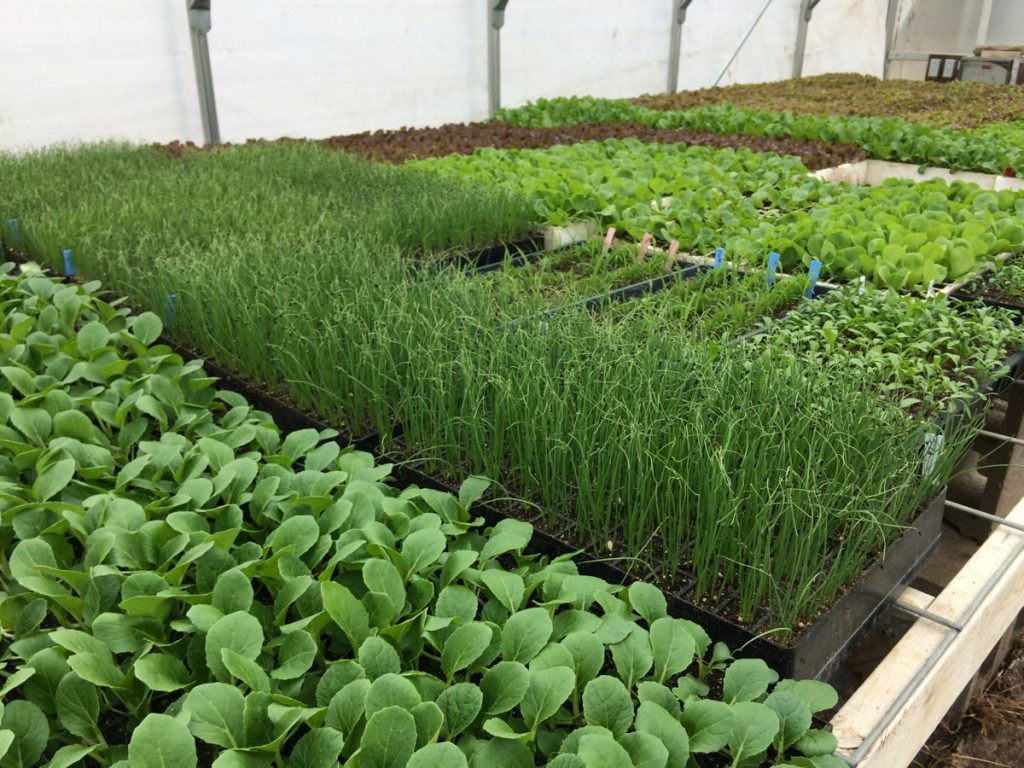
Bok choy, scallions, lettuce and spinach seedlings.
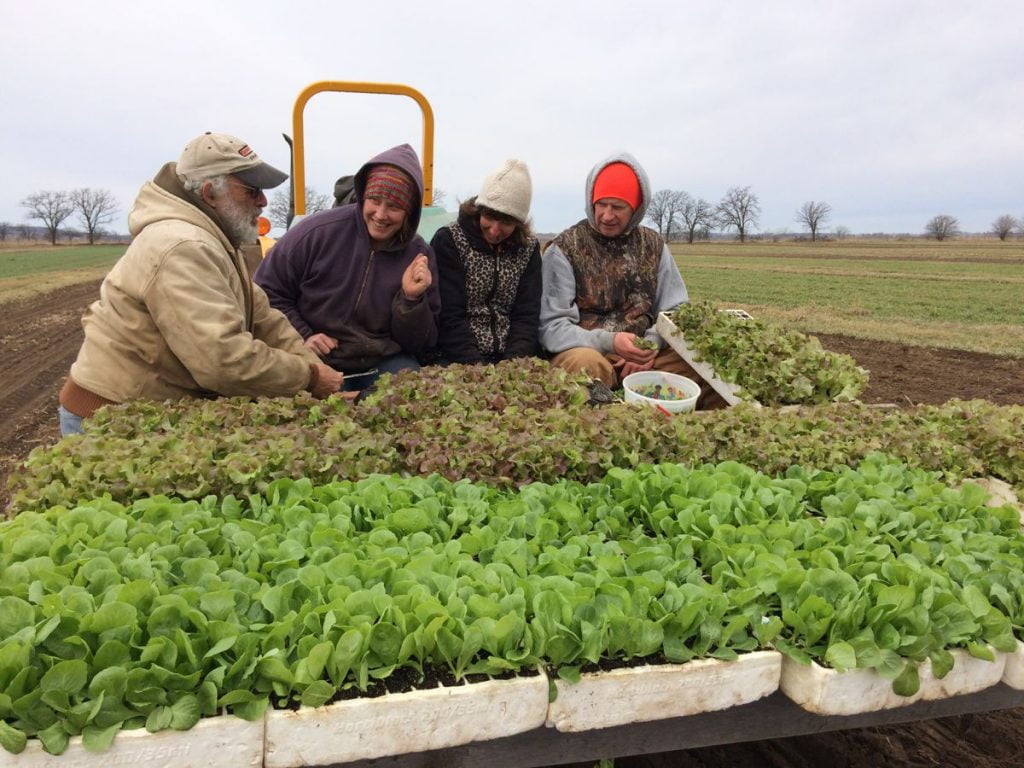
Transplanting day! Steve, Maggie, Kerry and Matt transplanted the first batch of spring crops last week. We hurried to get them in the ground before the weather turned wet.

It’s been two weeks since Steve planted the first seeds directly outside. He’s planted lots of peas, arugula, salad turnips and spinach.
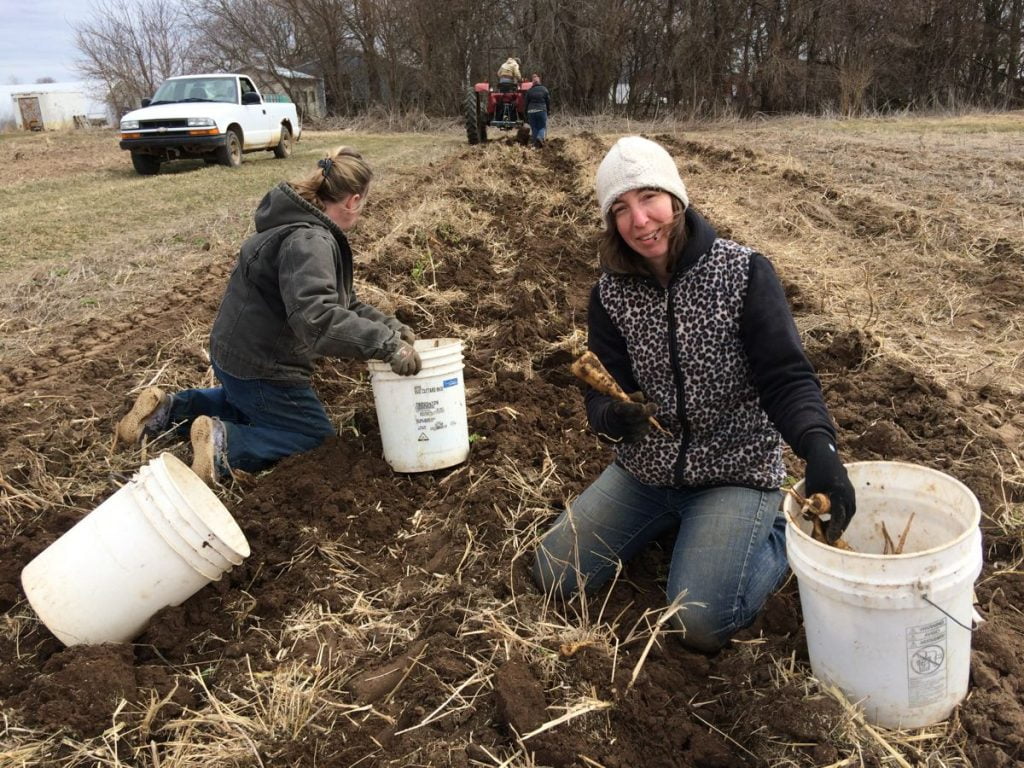
Simone and Kerry dig up over-wintered parsnips. We will sell these to Willy Street Coop while they are fresh, rather than trying to hold them for the CSA boxes.

We hired local carpenters to rebuild our pack shed this winter. They did a beautiful job and we will enjoy the improved space. My favorite part of the project? The carpenters sang while they worked, and their music changed as they built the building around themselves.
Storage Share, Nov. 17/18, 2016
- On: November 16, 2016
 0
0
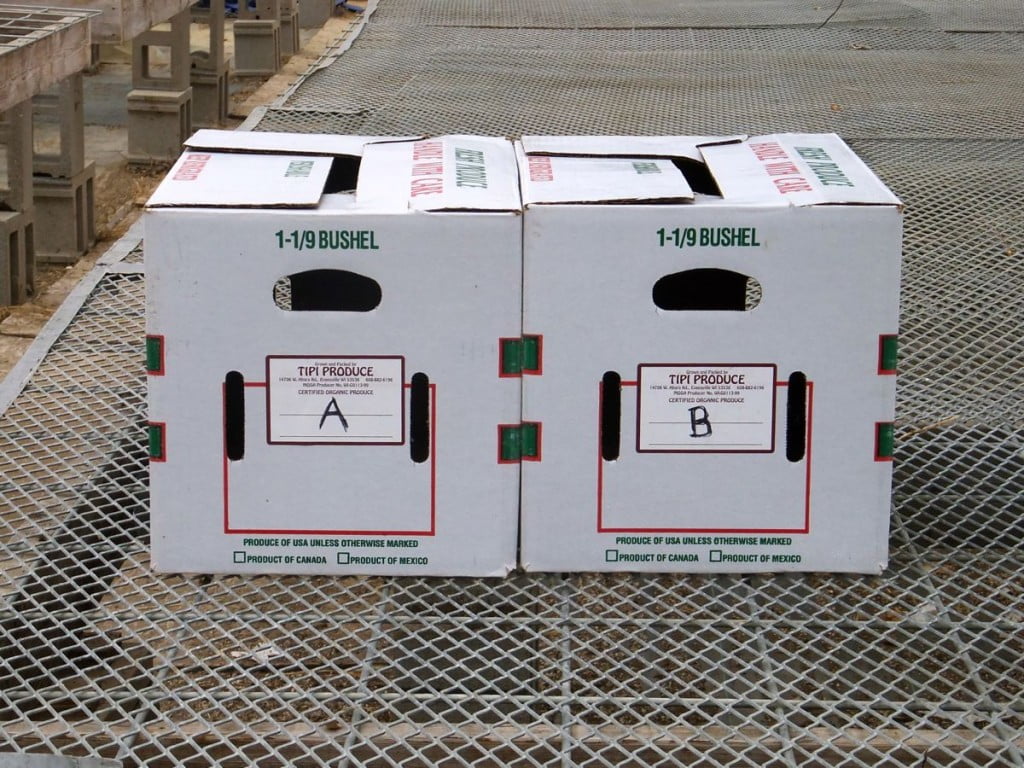
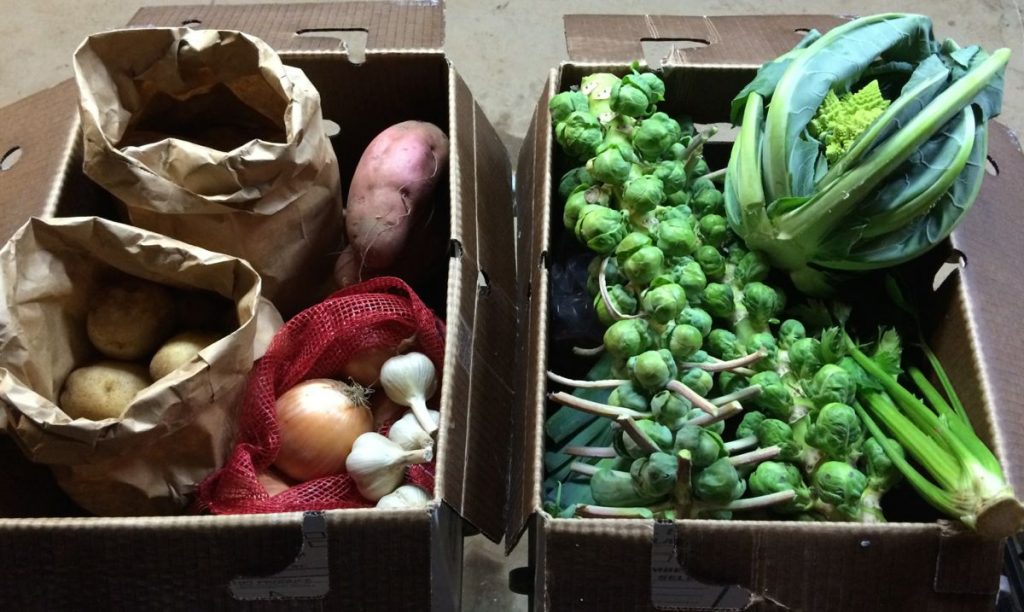
Take one box labelled “A” and one box labelled “B”.
Things you need to know about your winter share
* Your delivery will consist of two different boxes, labeled “A” and “B”. Take one “A” box and one “B” box. The boxes contain different vegetables.
* Please pick up your boxes on the day of delivery, during the normal hours for your site.
* Outpost members, please get your boxes on Friday. This is the busiest weekend of the year for the Outpost staff, so we cannot ask them to hold boxes past Friday.
* Members at outdoor sites, please carefully put the blankets back on the boxes. That keeps everyone’s produce in good shape.
* The boxes are heavy! It’s OK to take home the packed boxes, then return the empty boxes to your pickup site within two weeks. We’ll swing back and pick them up.
Veggie List and Storage Info (Storage share, Nov. 17/18, 2016)
We hope you enjoy this shipment of veggies! Strategize to use them well, as some will last longer than others. It was not a good winter squash year for us, so there are fewer squash than last year. Fortunately, the sweet potatoes over-performed to compensate.
* These vegetables are the most perishable: broccoli, Romanesco cauliflower, celery.
* These are the next-most perishable: Brussels sprouts, cabbage, leeks and onions. Keep an eye on your butternut, potatoes and sweet potatoes. The last two are susceptible to drying out.
* These will last the longest: Beauty Heart radish, beets, carrots, celeriac, garlic, parsnips.
Box “A”
Beauty Heart winter radishes, 1 to 3
Beets, 3 lb
Broccoli, 1-2 small head(s)
Brussels sprouts, on stalks
Carrots, 6 lb mixed colors
(orange 4 lb, yellow 1 lb, purple 1 lb)
Celeriac, 1 or 2
Celery
Green cabbage
Leeks, 2+ lb
Parsnips, 3 lb
Romanesco cauliflower
Box “B”
Sweet potatoes, 14+ lb
Butternut squash, 1 or 2
Russet potatoes, 5 lb
Superior (white) potatoes, 5 lb
Yellow onions, 5 lb
Garlic, 4
Beauty Heart radishes (round, white with pale green shoulders and bright pink interior) – Refrigerate. The interior color is lovely. Slice thinly and add to salads, cook lightly in mixed vegetable medleys or cut into matchsticks and add to pasta salads. We enjoy grated carrot and Beauty Heart salads all winter.
Beets – Refrigerate in a bag or container. Beets will store for two months or longer.
Broccoli – Refrigerate in a bag or container.
Brussels sprouts – Pluck from stalks and refrigerate in a bag or container. Eat soon.
Butternut winter squash – You will receive one or two Waltham butternuts, depending on size. Store your butternut in a cool, dry place. 50 F is ideal. Do not put in a plastic bag. Inspect your squash frequently and cook promptly if you see any soft spots developing. You can cook, mash and freeze the squash for future use. I find that you can refrigerate cut raw squash for up to one week. This runs counter to the accepted way to store squash, but is useful if you want to cook just half a squash. Try microwaving your squash for one to two minutes before cutting or peeling. This softens the squash and makes a large butternut easier to handle.
Cabbage – Refrigerate. Cut off chunks as needed.
Carrots, orange. Refrigerate in a plastic bag. Will keep for several weeks.
Carrots, yellow and purple. These varieties are pretty AND they taste good. The purple carrots will turn your tongue green. That should get the kids interested.
Celery – It took all year but the celery is finally ready, just in time for Thanksgiving stuffing. Cover and refrigerate.
Celeriac – Will store for months in your fridge. Cut off chunks as needed. Peel before using. I find it easiest to cut the celeriac into flat slices, then peel.
Garlic. Can be stored at room temperature.
Leeks. Refrigerate and eat within three weeks. Leeks are not a long-storage crop. You may need to strip off one or two outer leaves to freshen the leeks before you cook them. Your leeks will probably need washing. We finished preparing them after dark and didn’t realize how much soil was still on them.
Onions: Refrigerate or store in a cool, dark spot and protect from light. Exposure to light stimulates sprouting.
Parsnips (These look like large white carrots.) – Refrigerate in a plastic bag. Parsnips will store for two months but will darken in color. That is a harmless change.
Potatoes, Russets and Superiors – Can be stored at room temperature or in a cool spot, but must be kept in the dark so they do not turn green. A cloth or loose plastic bag draped over the paper bag will help avoid moisture loss, but do not close the plastic bag. Both types will store longer if kept cool. Around 40 – 50 F is ideal. The Superiors were grown by our friends/neighbors Peg and Matt Schaeffer. The Igl family near Antigo grew the russets.
Russets– We got the big ‘baking’ grade from Brad Igl so you have nice bakers for Thanksgiving. Excellent for mashed potatoes.
Superiors– Matt says these are good all-purpose potatoes, their family’s favorite for oven fries or for potato salad.
Sweet potatoes – These are a mix of the Covington and Beauregard varieties. Both types have developed excellent flavor and sweetness. This was our best-ever sweet potato crop. Store at room temperature, no lower than 55 F. Keep them on your kitchen counter where it’s easy to keep an eye on them. I like to keep ours in a paper bag so they don’t dehydrate. Cook promptly if they start to soften. The roots come in a wide ranges of sizes and all are good.
What are you cooking for Thanksgiving?
We are creatures of habit when it comes to Thanksgiving. Here are our plans so far: brined roast heritage turkey (Beth), Brussels sprouts with garlic-mustard vinaigrette (Steve), roasted sweet potatoes with garlicky yogurt dip (Sophie), glazed butternut squash (Beth), crunchy carrot-Beauty Heart salad with sesame-seed dressing (Steve), pickled onions (Beth & Ari), pickled peppers (Beth & Ari), pickles (Beth & Ari), homemade applesauce (Ari), and apple pie (Sophie). I’ll probably make stuffing with lots of celery, onions and mushrooms but that might be overkill. We love celebrating Thanksgiving and the end of harvest season!
Menu Ideas
There are many terrific Thanksgiving menus and recipes online right now. Many include vegetables that you will receive in this delivery. Search any of the sites below if you are stumped about what to do with your storage share. Check out the Thanksgiving collections online soon; they get taken down quickly after Thanksgiving.
* The New York Times Cooking app keeps getting better and better. They post appealing recipes and recipe collections every day. They have gone completely overboard for Thanksgiving this year, and have posted a Thanksgiving menu planner with 14 sub-categories, e.g. “Thanksgiving desserts that are not pies,” and “Thanksgiving appetizers,” and “Thanksgiving Sweet Potatoes.” In my opinion, Melissa Clark is the best NYT food writer. She’s practical and her dishes are always flavorful. David Tanis is my second-favorite. Recipes from Mark Bittman and Martha Rose Shulman are always worth a look. The app and recipes appear to be free to the public, but I think you need to be a NYT subscriber to save recipes.
* I like the lively Food52.com site, and always read the community comments.
* Smitten Kitchen is our go-to site for dessert recipes but has excellent veggie recipes too. Plus blogger Deb Perelman is funny. She has posted her Thanksgiving recipes and says that, this year, she is all about Team Casserole.
* The Kitchn. I found this site after wandering over from their Apartment therapy home-design site. Good recipes. Right now, they are featuring “Twenty Thanksgiving side dishes that travel well.”
* 101cookbooks. Always has good vegetarian and whole-grain recipes.
* Finally, remember that we have access to the entire catalog of Local Thyme recipes all winter. Check them out for Thanksgiving ideas.
Do you have favorite menu sites for fall and winter recipes?
If so, please share in a comment!
RECIPES FROM LAUREN
Autumn Root Vegetable Gratin
Adapted from Food 52
As much as I love stuffing (and that is a whole heck of a lot), I may go so far as to deem this the most festive Thanksgiving recipe that ever existed. It’s something about the abundance of local veggies effortlessly sliced and stacked high and the creamy richness that reminds me of all of my mother’s homecooking. This dish is elegant, decadent and exactly what you need on your Thanksgiving table. Oh and when I mention all that effortless slicing, note that I own a mandoline.†
Serves 8-10
Takes 90 minutes
3 cups whole milk
4 smashed garlic cloves
Pinch or two of ground nutmeg
2 tablespoons olive oil
1 medium to large sweet potato, peeled and thinly sliced (1/8-inch)
1 celeriac, peeled and thinly sliced (1/8-inch)
1 pound Superior white potatoes, peeled and thinly sliced (1/8-inch)
1 pound parsnip, peeled and thinly sliced (1/8-inch)
Salt and pepper
1/2 teaspoon dried thyme
1/4 teaspoon dried rosemary
2 cups of your favorite melty cheese (I always lean towards Gruyere or Fontina), shredded
2 cups finely shredded Parmesan cheese
- Preheat oven to 400 degrees.
- Add milk and garlic cloves to a medium saucepan. Heat over medium low heat until it just begins to bubble. Remove from heat and add nutmeg.
- Find a casserole or baking dish that is oven-safe and holds at least 12 cups. Rub the bottom and all sides with olive oil.
- Now you start stacking. Layer the veggies into the baking dish alternating sweet potato, celeriac, potato, parsnip, etc. in concentric, overlapping circles. You should use about 1/4 of the veggies for each layer. After each layer, season with salt and pepper, a sprinkling of the dried herbs and 1/4 of each cheese. Continue until you use up all the ingredients.
- Remove the garlic from the milk and pour evenly over the gratin. Bake for 45-60 minutes until bubbly and golden brown on top. Let the gratin sit and set for 5 minutes before serving. Enjoy!
—————-
Cornbread Stuffing with Leeks, Brussels Sprouts & Celery
Good stuffing takes a while. There is nothing you can do about it. The most time intensive part of this recipe comes after you pour everything together and get it roasting in the oven. I stirred my stuffing every 15 minutes to get an even browning, but if you want to run away from the kitchen for the 90 minutes it takes to roast, I’d tack on an extra 30 minutes and just expect the edges and bottom to be a little more browned than the center. Both methods will taste delicious.
Serves 10-12
Takes 2 hours, 30 minutes
3-4 tablespoons olive oil, divided
1 large yellow onion sliced
2 leeks, white and pale green parts only, halved and sliced
1 head celery, leaves removed and sliced
2 teaspoons Kosher salt
1/2 teaspoon black pepper
1-2 tablespoons olive oil
4 garlic cloves, minced
2 cups halved Brussels sprouts (quartered if large)
1-1/2 teaspoon dried sage
1 cup dry white wine
4 cups chicken broth, divided
2 tablespoons maple syrup
Large pinch red pepper flakes
2 eggs
2 cups whole milk
10 cups dried cornbread cubes* (see note below)
*For the cornbread you can use leftover stuff that you froze from an earlier meal or make it from scratch. You can also use store-bought. Regardless of what you decide to use, make sure you cut it into crouton-size pieces †the day before you plan to make the stuffing and leave them out on a single layer on a couple baking sheets. You want the cornbread to really dry out. It will still break up a bit when you add the liquid, but don’t distress!
- In a large cast-iron skillet, add 3 tablespoons of olive oil. Add onions, leeks and celery to pan along with salt and pepper. Saute over medium heat for 10 minutes, stirring often. Add garlic, reduce heat to low and cook 5 minutes more.
- Add the remaining tablespoon of olive oil at this time if the pan appears to be getting dry. Add brussels sprouts and sage to pan. Bring back up to medium and cook for 5 minutes.
- Preheat oven to 400 degrees.
- Add wine to pan and reduce until liquid is gone. It will probably be simmering pretty aggressively. Turn down to medium low if there is too much splatter. Add 2 cups of chicken broth and continue to simmer and reduce. This will help make the veggies more tender and flavorful. You want to keep simmering for 5-10 minutes until the liquid is mostly reduced. Add maple syrup and red pepper flakes and stir to combine. Turn off heat. Taste and adjust seasonings as desired. It may be a little salty, but that’s alright. You won’t be adding salt to egg mixture.
- In a large bowl, combine remaining chicken broth, eggs and milk. Whisk until smooth.
- In the a large, deep baking dish (at least 9×11), combine cornbread cubes and cooked veggies. Evenly pour egg mixture over cornbread vegetable mixture. Stir gently with a spatula to just combine. The cornbread pieces may fall apart. It may look like a big sloppy wet mess. Okay, it definitely will. Don’t stress. Let the oven work it’s magic!
- Bake for 90 minutes, stirring with a spatula every 15 minutes for more even baking and moisture.
- Serve warm with all the turkey and mashed potatoes you can get your hands on!
—————-
Extension share = an encore box
- On: November 02, 2016
 0
0
Last week, we said “thank you and good bye.” Just kidding. Now it’s time for an encore.
This is the first time we have offered an optional Extension share. We made the change to ease a work crunch that occurs this time of year. Our carrots, cabbage and other storage crops are all harvested during an intense two weeks in November. Packing CSA boxes in the midst of that effort has always felt insane and risky. The days are short and often cold by now. The weather is mild this fall but we have harvested during snow storms in other years. We feared that, some year, working on a CSA delivery would cost us a storage crop.
This year, we shortened our regular CSA share from 26 weeks down to 24 weeks. Adding this week’s extension share allows 25 consecutive weeks for you folks, and frees one week for us to focus on field work. I think allowing ourselves one streamlined week will ease our lives greatly.
Our fall crops are not great this year but there’s still work to be done and coolers to fill … halfway. Quality looks excellent but the amounts to harvest are simply smaller than last year.
In two weeks, we will pack Storage shares for those who signed up. We will update you then on how our fall work proceeded. We’ll be in touch soon once we open our 2017 registration. After that, we say goodbye until spring.
Beth
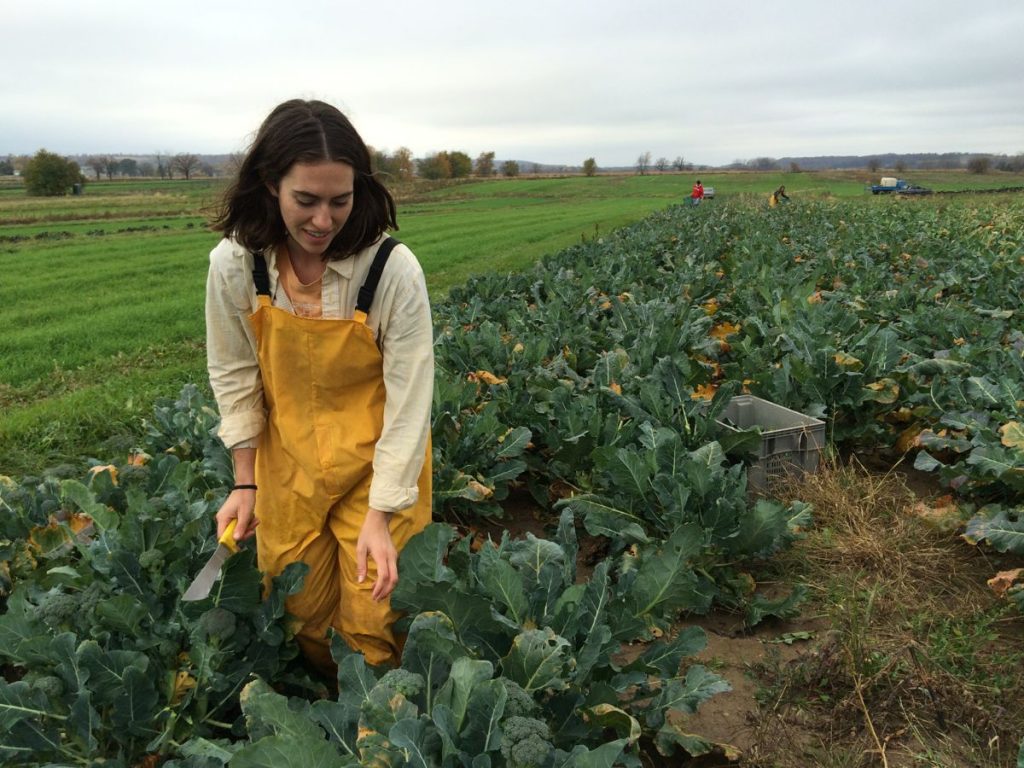
Lizzy harvests broccoli. We love the mild weather. No hats, no gloves, no bulky winter coats!
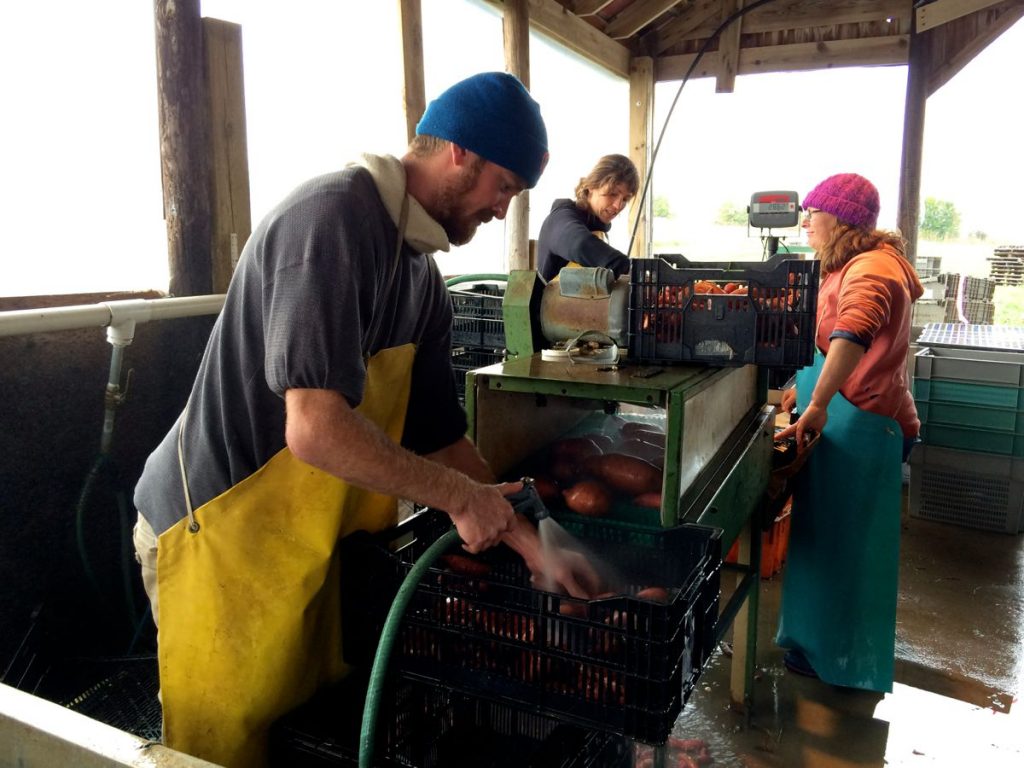
Billy, Charlotte and Kristin wash your sweet potatoes, another job that’s uncomfortable during typical November weather. Our seasoned crew members are tough enough for any conditions but, honestly, no one wants to be cold and soaked.
Veggie list and veggie notes (Extension share, Nov. 3/4, 2016)
Beth’s box logic. We are sending an array of root crops to roast together. I am intrigued with Pat’s recipe for Roasted Sweet Potatoes and Brussels Sprouts with Miso Vinaigrette. I’ve never tried that combination, although we often roast root vegetables this time of year. Here’s how I would roast this week’s roots. Start with parsnips, carrots (and turnips). Add potatoes if you have them. Even when roasted together, the roots retain their individual flavors. Cut in 1-inch chunks, toss with oil, spread in a single layer on a cookie sheet and roast at 400 F until tender. Stir once or twice while cooking. We add thick onion wedges at the beginning, but only a few because they release moisture. Turnips will flavor the other veggies so roast separately if you wish. Sweet potatoes cook more quickly so roast separately and combine with the other roasted roots at the end. Serve with Brussels sprouts steamed and dressed with slivered onions and a mustard-vinaigrette. Alternatively, make a batch of bean and leek soup with roots or cauliflower. Cook sliced collards in the soup for a one-pot meal.
I was eavesdropping in the grocery store and overheard this: “Just steam the cauliflower until tender, then puree it in the blender. Melt the cheese into the cauliflower and your sauce is done.” I thought to myself “Why have I never done this??” I wish I’d asked the young woman how she uses the sauce but we can figure that out on our own.
Sweet potatoes, ~ 3 lb
Brussels sprouts, ~ 1 lb
Parsnips, 1.4 lb
Carrots, 2 lb
Leeks, 1 lb
Collard greens, 1 bunch
Turnip(s)
Yellow onion(s)
Garlic
Some sites get cauliflower (white or orange or purple).
Some sites get Romanesco.
Some sites also get a little broccoli.
Sweet potatoes – These are from our second Beauregard harvest. The roots are bigger than the last Beauregard delivery; they really bulked up during the three weeks between harvests. As usual, we will distribute a range of sizes. All are good.
Brussels sprouts – This is terrific Brussels sprouts weather and they are finally plumping up. This week’s sprouts are noticeably larger than the ones we sent last week.
Parsnips (tapered, cream colored roots) – Those long, white roots are not carrots, they are parsnips. The two vegetables are related. When cooked, parsnips are sweet and starchy. For the best flavor, brown them to caramelize the sugars. Here are a few ideas for parsnip preparation:
– Caramelize the parsnips by roasting them in a vegetable medley.
– Parsnip fries are delicious: cut like French fries, coat very lightly with oil, place on a cookie sheet and roast in a hot oven until brown and cooked through.
– Try substituting grated parsnips in a potato pancake recipe. They brown beautifully and are very tasty.
– Steve loves pan-fried parsnips with onions and garlic.
Turnips (round root, white with purple shoulders) – Add these earthy roots to hearty grain-based stews or include in a pan of oven-roasted roots. Lauren offers some good ideas in her recipes.
Storage: Cover and refrigerate. Will store well for about one month.
RECIPES FROM LAUREN
ROOT VEGETABLE POT PIE
I love pot pie. I absolutely adore it. It’s not an everyday or even an every week kind of meal, but a few times per year, we make pie dough from scratch, stuff it†with all the savory things and just love every bite of flaky, creamy, rich delicious goodness. This pot pie is a little different than normal. It’s totally vegetarian and packed full of everyone’s favorite fall root vegetables. If dining on veggies and butter along is not your thing, you could buy a rotisserie chicken, shred it and add it to the mix. You could dice up some ham or some bacon if you really need some meat in this dish, but I love to let the vegetables sing all on their own.
I prefer the pie dough made from scratch and always, always follow Smitten Kitchen’s directions for the perfect each pie crust. Make the pie dough the day before and stash it in the fridge for a super easy weeknight dinner.
Serves 6-8
Takes 1 hour, 15 minutes (excluding time to make pie crust because hopefully you made it the night before or bought the store-bought stuff)
4 tablespoons butter
1 pound leeks, white and pale green parts only, cut in half lengthwise and sliced
2 cups peeled and diced sweet potatoes
1 cup peeled and diced carrots
1 cup peeled and diced turnips
1/4 cup flour
2 cups chicken broth (or vegetable broth if vegetarians), plus more if needed
1 teaspoon dried thyme
1/2 teaspoon dried sage
1/4 cup milk
Kosher salt and freshly ground black pepper
1 batch Smitten Kitchen All Butter, Really Flaky Pie Dough, preferably made ahead of time & chilled
Flour
1 egg
1 tablespoon water
- Preheat oven to 375 degrees.
- In a Dutch oven or stock pot, melt butter over medium heat. Add leeks along with a generous amount of salt and pepper. Saute for 5 minutes until fragrant. Add sweet potatoes, carrots and turnips. Cook for 5 minutes until soft.
- Reduce heat to medium-low and add flour. Stir well so that it evenly coats all the veggies. Keep cooking and stirring occasionally for a minute or two so that the flour starts to turn a light golden brown.
- Add chicken broth (or veggie broth), thyme and sage. Stir well to evenly incorporate the flour. Simmer gently for 5 minutes. Add a quarter cup of milk. Continue to simmer for 2-3 minutes. If the mixture seems too thick, add a little more broth. You want it to be a little thicker than a soup and a little less thick than a regular white sauce. Taste and adjust seasonings as desired.
- On a well-floured surface, roll out half of your chilled pie dough to fit in a deep 10-inch pie pan. (If you don’t have one, roll it a little thinner and fit it into a casserole dish). Add mixture.
- Roll out the remaining half of of the chilled pie dough on a well-floured surface. Lay it on the top of the dish and press down the edges to seal. Use a knife to cut little vents on the top crust.
- Combine egg and water in a small bowl until smooth. Brush over pie crust. Bake for 25-30 minutes until crust is golden brown. Enjoy!!
—————–
BRUSSELS SPROUTS & PARSNIP HASH
Adapted from a New York Times recipe
Takes 45 minutes
Makes 4 servings
2 tablespoons oil
1 pound Brussels sprouts
1 teaspoon Kosher salt, divided
1/2 teaspoon red pepper flakes
Generous freshly ground black pepper
2 parsnips, peeled and chopped
4 tablespoons butter
1 medium onion, diced
2 garlic cloves, minced
1/2 pound pork sausage, cooked
1 1/2 tablespoons dried sage
- Preheat the oven to 400 degrees. Prep your Brussels sprouts by cutting them in half (quarter especially large ones; leave especially small ones whole). Toss with olive oil, 1/2 teaspoon salt, generous amount of black pepper and red pepper flakes.
- Place on a baking sheet and bake for 25-30 minutes or until nicely brown and crispy around the edges, turning occasionally for even browning.
- Put parsnips in large oven-proof skillet. Cover with water. Simmer over medium heat for 3 minutes. Drain and remove from pan.
- Melt butter in same large skillet. Add onion along with 1/2 teaspoon salt and more freshly ground black pepper. Cook for 5 minutes over medium-low heat until soft. Add garlic and cook 3 minutes longer. Add cooked parsnips, pork sausage and sage.
- Turn heat to medium-high and cook for 20 minutes, stirring every couple of minutes. The idea here is to brown the parsnips but not burn them. Your pan should be so hot that you can leave it for 2 minutes without stirring and when you come back, things will just be nicely browned. If the parsnips or onions burn in 2 minutes, your pan is too hot.
- After things are nicely browned, put pan in the oven. Roast for 10 minutes. (This timed nicely for me, as my Brussels sprouts had exactly 10 minutes left). Toss hash with roasted Brussels sprouts. Top with some fried eggs and bam! Vegetable-centric meal in 45 minutes or less.
—————–
LOCAL THYME RECIPES
Comforting Classics
Apple Brussels Sprout Slaw
Warming Stone Soup
Slow Cooker Sweet Potatoes
Beef Barley and Winter Vegetable Stew
Outside the Box Recipes
Roasted Sweet Potatoes and Brussels Sprouts with Miso Vinaigrette
Stuffed Collard Greens with Moroccan Spiced Quinoa
Sweet Potato Breakfast Treat
Parsnip Biscuits with Black Pepper and Honey
Quick and Easy Meal
Thank you!
- On: October 26, 2016
 1
1
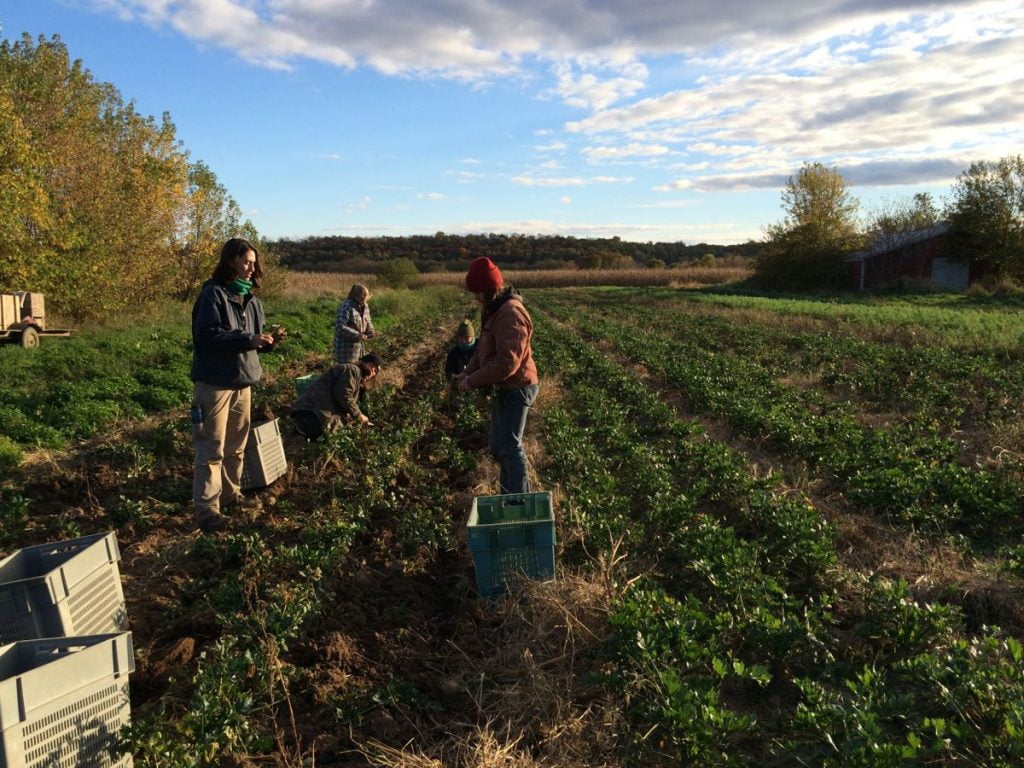
Celeriac harvest on a lovely fall day.
This is the final box of our regular season. Thank you Tipi members! We truly appreciate your commitment to our farm. We could not farm without you.
Many of you have signed up for continued deliveries with our extension and storage shares. We will be in touch with more information as those deliveries approach.
We will open registration for our 2017 season within a few weeks. Watch for emails from us. In the meantime, you can continue eating our produce through the winter. Our stored cabbage, carrots and other roots will be on the shelves at these stores: Willy Street Coop (Madison, Middleton), Outpost Natural Foods (Mequon and Milwaukee area), Basics Coop (Janesville), Whole Foods (Madison only), Good Harvest Market (Pewaukee), and Health Hut (Brookfield).
How was the season? Our thoughts.
It has been a challenging year for us but you probably did not notice. It was a good year to test our version of CSA (Community Supported Agriculture). In the classic CSA model, you as members, would share in the risks of the farm. We operate a little differently. More than half the crops we grow are intended for our store customers but are available to the CSA as needed, providing a reliable buffer in a poor season. We dipped into that reservoir this year to make sure you got your expected value of good produce. For example, beets, summer carrots, and leeks all had smaller harvests than expected so we put them all into your CSA boxes. We were glad to have that supply at hand.
It was an unusually long growing season, with a record-early start. We were in the fields planting radishes and spinach in mid-March. The season extended with a mild fall, allowing us to harvest peppers right up to this week. Humid, rainy days in August and September did not do us any favors. The greatest effect was on our fall crops, then in their adolescent phase. This is why we grow 40 different crops. Each year, something will do poorly but something else will do well and take its place. That’s the nature of a mixed vegetable farm like ours.
It was a good year for peppers and watermelons. The greens and most summer crops thrived. The sweet potatoes are terrific. The cauliflower and Romanesco were late to produce heads but we are thrilled with how much we’ve had to harvest recently.
Our work crew was wonderful this year, both newcomers and old hands. They were a joy to work with: smart, diligent, thoughtful, and kind to each other.
Our field work will continue for another three weeks, as we bring in cabbage, carrots and other roots to store and sell through the winter. It’s always a big effort, so we are preparing mentally and physically. Steve has run through his checklist. The carrot harvester is ready to go, with new modifications. The wooden storage bins are all in good shape. Steve and Roger are tightening up the coolers for winter. We expect to have all the crops out of the field by mid-November. Then we can slow down for a few months. Our crew drops from 25 people down to five. That’s enough people to prepare and deliver our winter crops. In December and January we will mull over our 2017 plans so we can order seed. Greenhouse work begins by early March, and everything flows from there. Soon we will wrap up our time as the Organic Farmers of the Year. It has been a very special year for us.
Thank you again for your patronage. We are already envisioning changes and progress for next year. Join in and give us your feedback.
Beth and Steve.
How was the season? YOUR thoughts.
Now it’s your turn to share your thoughts. Please complete our annual survey. I sent the link in our 10/27/16 email, and look forward to poring over the results. This is an essential part of the CSA model – we need to hear from you to make the CSA work for you.
This week on the farm
We kept ourselves busy with farm maintenance, in anticipation of our big upcoming harvests.
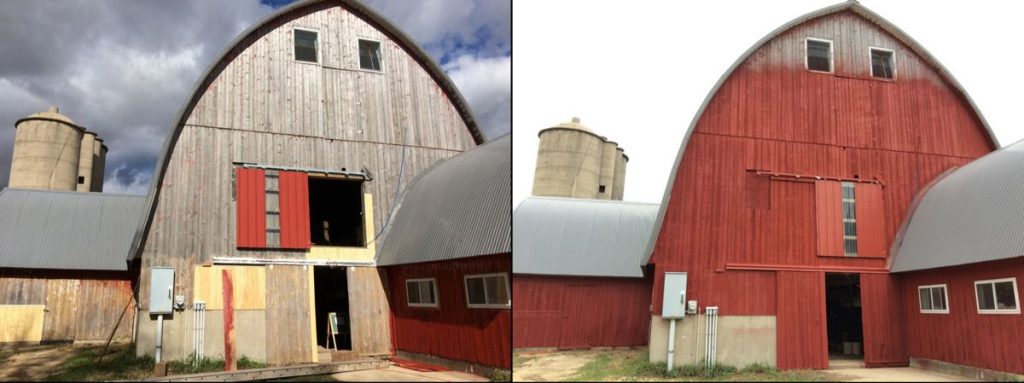
Our beautiful barn, before and after painting. Roger completed the project in a day and half, with helpers, a lift, harnesses and an extended handle on his paint sprayer. We almost made it to the roof peak. The top gap will have to wait until a friend’s taller lift is available.
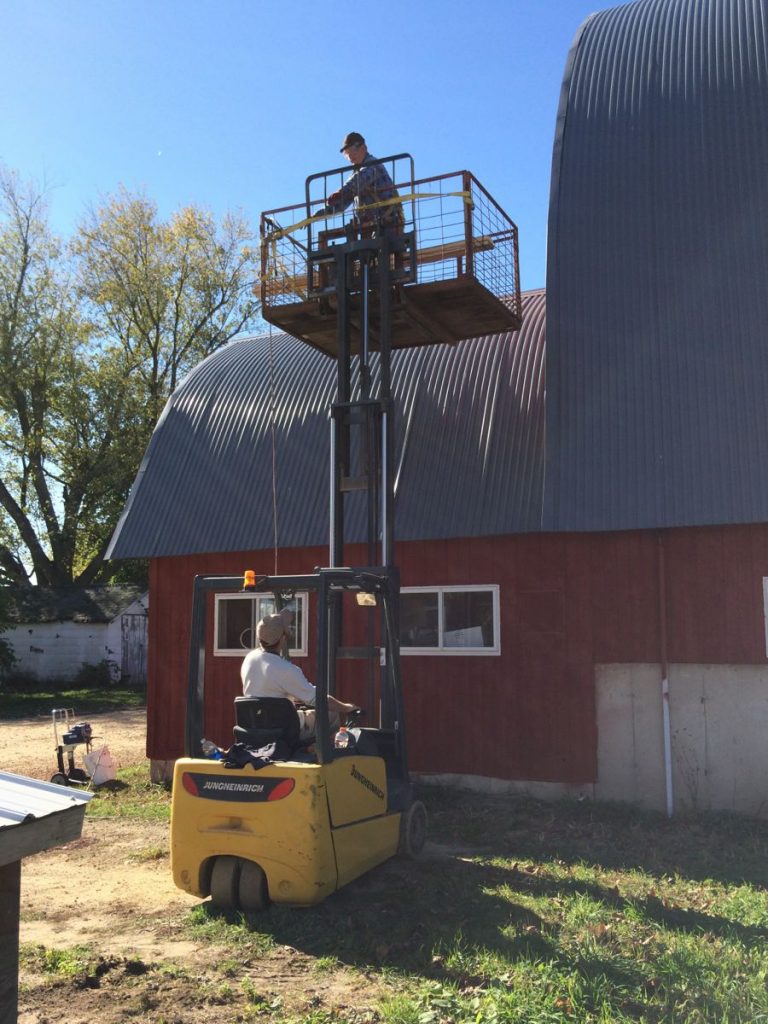
Roger in the cage, with Billy steering.
Veggie list and veggie notes (Oct 27/28, 2016, week #24, purple EOW)
Red cabbage
Sweet potatoes, 2+ lb
Brussels sprouts, 0.6 lb
Kale, 1 bunch
Beets, 2 lb
Celeriac, 1 or 2
Yellow onions, ~2
Carrots, a few
A pepper of some sort
Jalapeños (HOT), 2
Baby ginger, 1 knob
Most sites get cauliflower (white or orange or purple) but we might pair it with Romanesco broccoli for some sites.
Sweet potatoes – These are the Covington variety. This is an especially tasty batch. Let’s repeat my newsletter information from a few weeks ago.
Here are a few things we’ve learned about sweet potatoes:
– For best flavor, cook your sweet potatoes so they brown and caramelize. We have a simple, favorite way to roast sweet potatoes. We used to prepare sweet potato fries. Now we just quarter the potatoes, rub with olive oil, dust with salt and place cut-side-down on a cookie sheet. Roast in a 450 F oven without turning until soft. The flavors will caramelize (like sweet potato fries) but preparation is simpler and the cooking time less exacting. Slender sweet potato fries go from undercooked to overcooked in the blink of an eye. Larger slices are less exacting, and therefore are easier. Small sweet potatoes can be cut just in half. Jumbos will need to be chopped into pieces. Otherwise, they will take a long time to cook.
– Store your sweet potatoes at room temperature. They suffer chilling injury below 50 F.
– The sweet potatoes we grow require slightly longer cooking than ones from the supermarket, perhaps because they contain higher moisture so soon after harvest.
– Sweet potatoes are good at any size. We have cooked everything from tiny to jumbo and consistently find that all sizes taste good.
Brussels sprouts – The B-sprouts have taken their time sizing up. Sprouts are small. I’ve given you our usual cooking instructions below, but recognize that all of this week’s sprouts are small.
Here is our method to cook Brussels sprouts. Wash the sprouts and trim the cut ends. Cut an X in the stem end of large sprouts. Cut a single slit in small or medium sprouts. This does two things. It helps the Brussels sprouts cook evenly, plus it allows them to soak up any marinade or dressing. Place sprouts in a pot with one inch of water in the bottom and steam until tender, 7 to 10 minutes. If the sprouts are uneven in size, then set aside the smallest ones and add to the pot after the larger ones have cooked for a few minutes. Don’t overcook them! You can also oven-roast Brussels sprouts. Here are a few dressing ideas for cooked sprouts:
– Sherry vinegar/olive oil/Dijon mustard/garlic/white wine/salt and pepper. This is our favorite, especially when you combine the Brussels sprouts with slivered peppers and thinly sliced onions. Delicious warm, cold, or at room temperature.
– Balsamic vinegar/olive oil/garlic/salt and pepper
– Lemon juice and zest/melted brown butter/poppy seeds/white wine/garlic/salt
Celeriac (knobby, round, bizarre-looking vegetable which smells like celery) – Flavorful celeriac is good raw or cooked. It is excellent in mixed roasted veggies or in soup. It’s especially good in cream soups, alone or mixed with potatoes. Grated raw celeriac is a great starting point for winter salads. Celeriac will store in your refrigerator for months. Cut off chunks as you need them. Peel before using.
Baby ginger – Wrap in a damp cloth or paper towel, and keep in the refrigerator in a plastic bag. Eat soon; baby ginger is perishable. It bruises easily so we gave it a light washing, and figured you could do the fine washing when you use it.
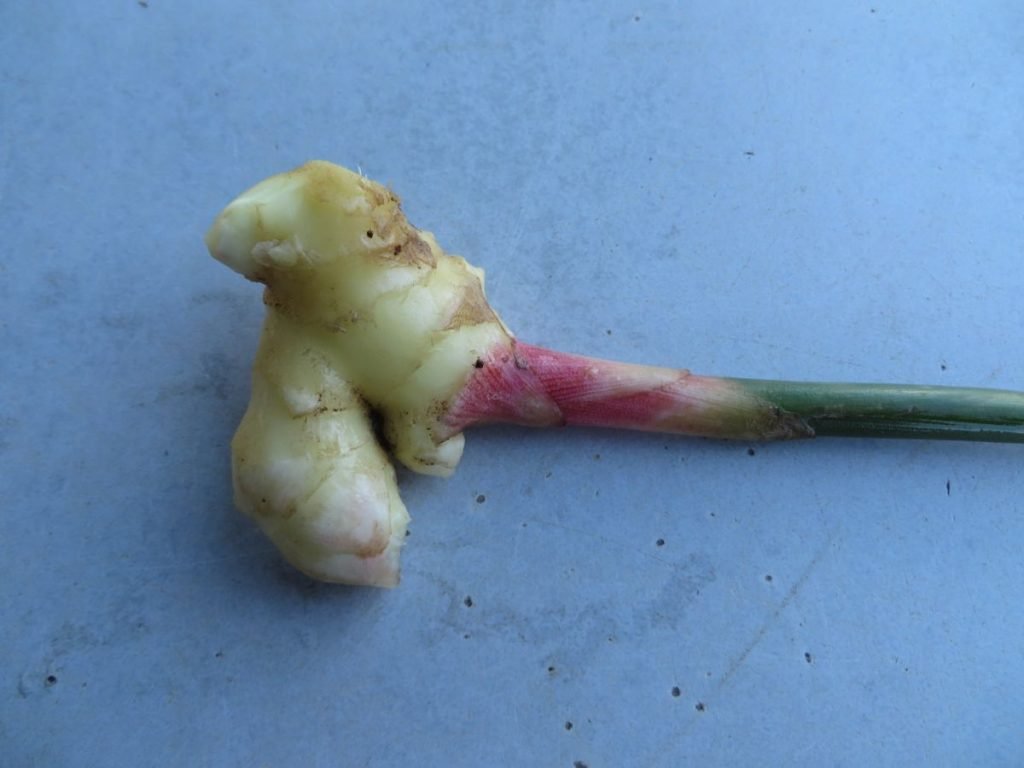
Everyone gets one knob of baby ginger.
RECIPES FROM LAUREN
GINGER, TURMERIC & COCONUT SOUP
Takes 40 minutes
Serves 4-6
2 tablespoon butter
2 carrots, diced
1/2 yellow onion, diced
1/2 celeriac, peeled and diced
1 jalapeno, seeded and diced
2 tablespoons minced ginger
1 teaspoon ground turmeric
1 teaspoon Kosher salt
1/2 cup white rice
3 cups chicken broth
1 can coconut milk
1 bunch kale (6-8 leaves), stems removed, leaves roughly chopped
1 teaspoon fish sauce
Lime wedges, to serve
- In a large stock pot or Dutch oven, melt butter. Add carrots, onion, celeriac, jalapeno and ginger. Saute for 5 minutes until fragrant. Add turmeric and salt and saute 5 minutes longer.
- Add rice. Stir for about a minute to combine rice and toast it gently. Add chicken broth, bring mixture to a boil and reduce to a simmer. Simmer until rice is cooked, about 15 minutes. Add coconut milk, kale and fish sauce. Simmer gently until kale is wilted, about 5 minutes.
- Serve with lime wedges.
————
SWEET POTATO & BRUSSELS SPROUT TACOS WITH RED CABBAGE SLAW:
Takes 1 hour
Serves 4.
5 cups diced and peeled sweet potatoes
1 cup Brussels sprouts, left whole if small, halved if a little larger
2-1/2 tablespoons olive oil
2 teaspoons Kosher salt
1 teaspoon cumin
1 teaspoon chili powder
1/4 teaspoon black pepper
Pinch cinnamon
Red Cabbage Slaw:
2 cups shredded red cabbage
1 red pepper (bell or fryer), seeded and diced
1 jalapeno, seeded and diced
1/2 yellow onion, diced
1 tablespoon olive oil
2 limes, juiced
1 teaspoon Kosher salt
1/2 teaspoon sugar
Flour tortillas
Avocado
Sour cream or Greek yogurt
Hot sauce, optional
- Preheat oven to 400 degrees and chop vegetables while you wait.
- Toss sweet potatoes and brussels sprouts with olive oil and spices in a large bowl to coat. Pour out onto a rimmed baking sheet. Roast for 40-45 minutes rotating occasionally.
- While the sweet potatoes and brussels sprouts roast, prepare the slaw. Combine all ingredients in a large bowl.
- To serve, top warm tortillas with a spoonful or two of sour cream. Add avocado, followed by warm roasted vegetables and cabbage slaw. Add hot sauce if desired. Enjoy!
- Roast at 400 degrees for 40-45 minutes
————
LOCAL THYME RECIPES
Comforting Classics
Cheddar Cauliflower Fritter
Chinese Spiced Hot Red Cabbage
Slow Roasted Vegetables with Mustard Seed Vinaigrette
Creamy Celeriac Dressing
Outside the Box Ideas
Roasted Cauliflower Salad with Hazelnuts
Sicilian Braised Red Cabbage with Capers and Olives
Red Velvet Cake
Celeriac with Lentils and Hazelnuts
Quick and Easy Meal
Final green EOW box
- On: October 19, 2016
 0
0
This is the final delivery for our green EOW members. Thank you for joining us this season! We hope you enjoyed the produce and the experience. We will be in touch with a survey in the next few weeks.
Here is our remaining schedule:
Oct. 20/21 (this week) – final week for green EOW members.
Oct 27/28 (next week) – final week for weekly and for purple EOW members
November – Deliveries are available in November for members who signed up for our extension or storage shares. Those already registered should have received a recent confirmation email from us. We still have a few shares available. If interested, go here to sign up. The deadline to register and pay is this Sunday Oct. 23.
Getting ready for the big push
By mid-November, our coolers will be stuffed with crops to sell through the winter. It’s almost time to begin these harvests. The carrots and other roots are growing happily underground, so we don’t want to interfere yet. We think carrots, in particular, improve in quality if they get a month of cool nights as they mature. In the meantime, we continue our usual CSA work, as well as preparations for the big upcoming harvests.

Steve is making improvements to his carrot harvester, the one we imported from Sweden last year. It is a monster! He loves the thing! It operates best with a team of two or three people but, in a pinch, Steve can run it solo. He beams after a successful run with this machine.
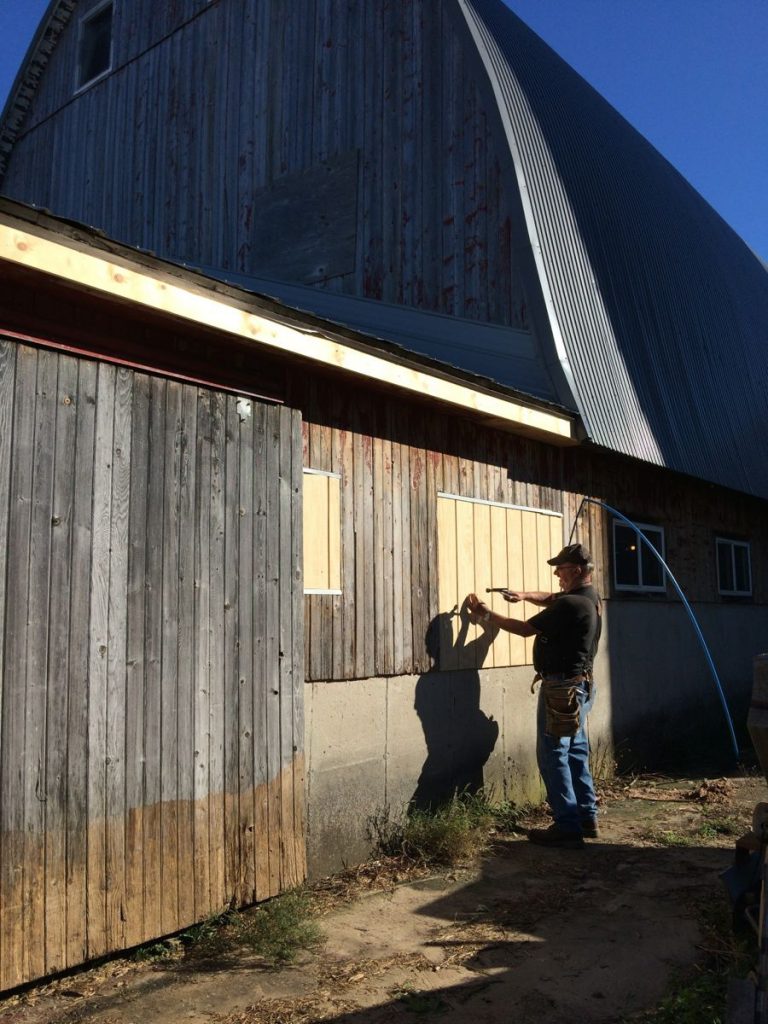
Roger patches weak areas on our barn. We plan to paint it next week if the weather holds.
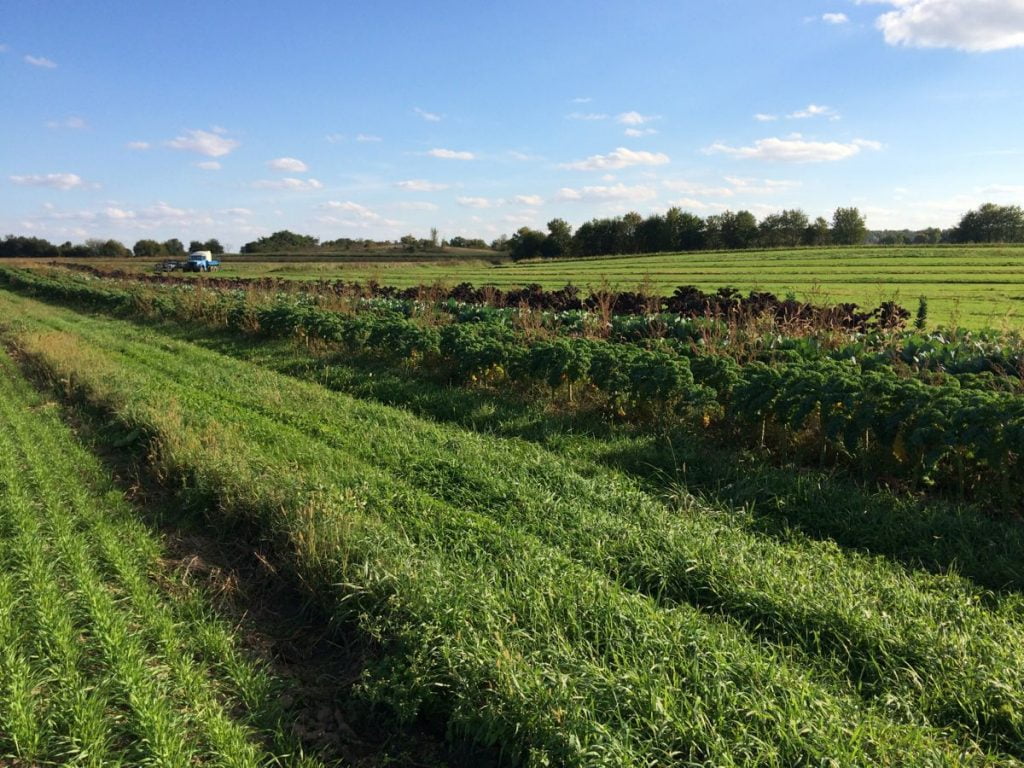
Looks like Ireland, doesn’t it? As each crop finishes, we plant the empty field with cover crops. The rye and vetch are in full, lush growth, a beautiful shade of green. The cover crops keep the soil from eroding over the winter then burst into growth in spring.
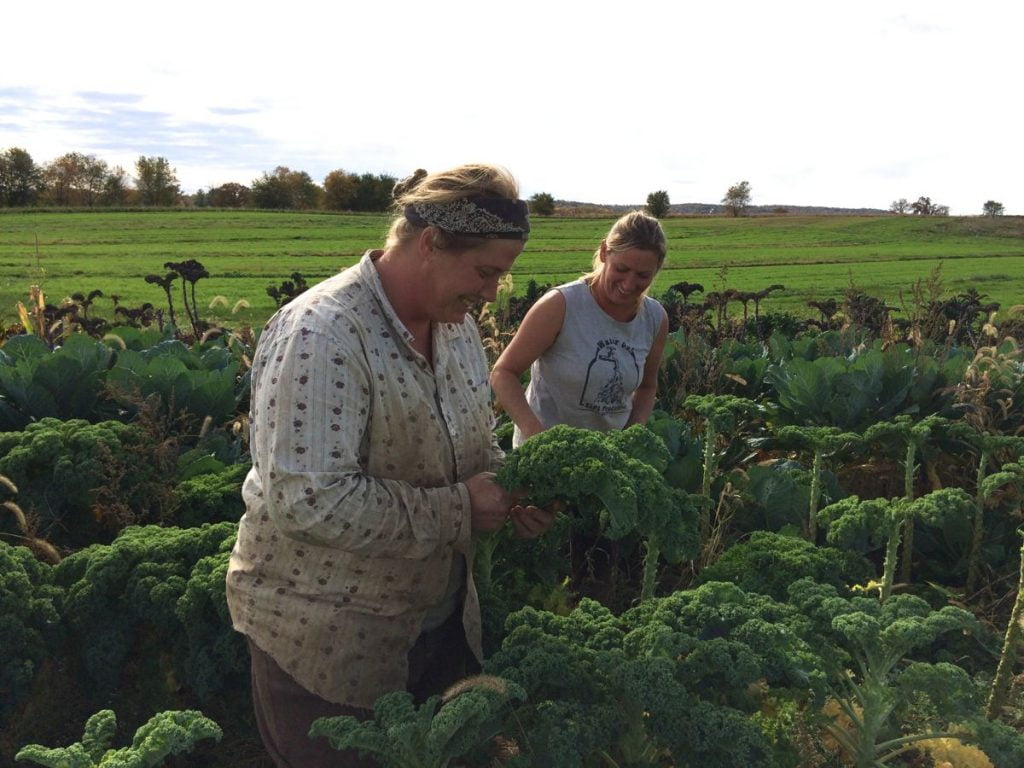
Maggie and Rebecca harvest kale. We’ve loved the mild weather. No rain, no snow, no mosquitos. Ahh.
Thinking ahead
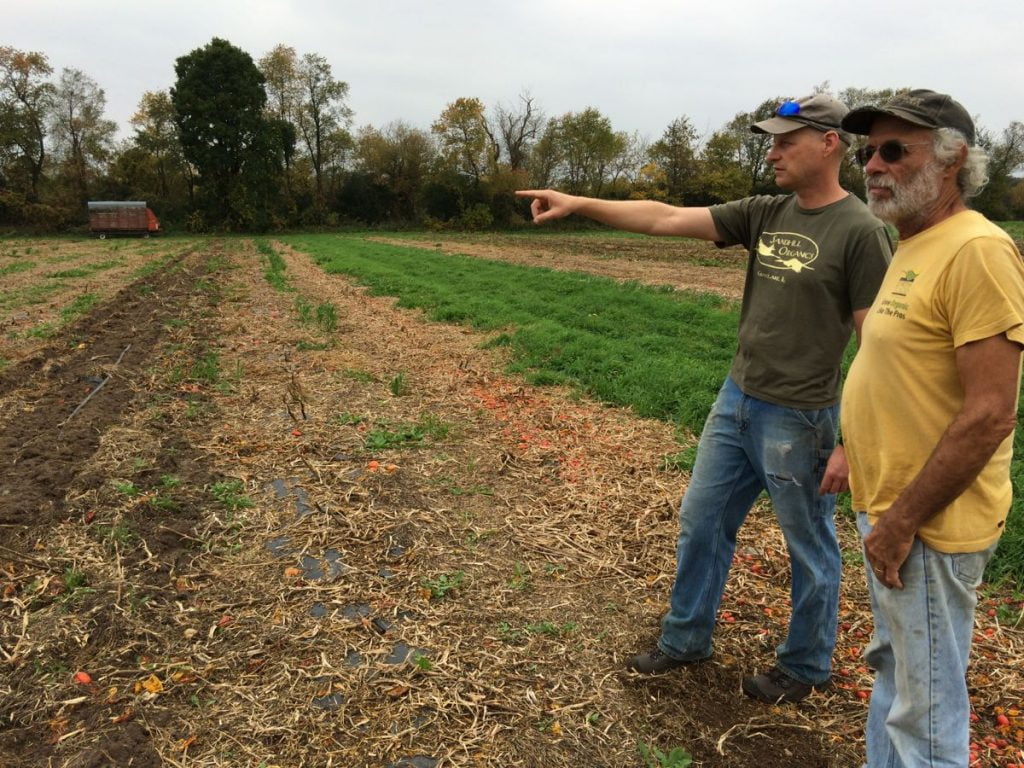
Matt Schaeffer and Steve check out the remains of Matt’s mulched fields.
It’s not too soon to ponder improvements for next year. Steve and I visited neighbor Matt Schaeffer of Sandhill Family Farms to pick up his potatoes for this week’s CSA box. Matt and wife Peg raise organic vegetables about 15 miles south of us. It’s interesting to swap farming notes because they are so close, and grow many of the same crops. Steve and I wanted to see the tomato fields that Matt mulched with a thick layer of straw and hay. It gave him good weed control in a rainy, challenging season. It’s an approach we are considering for next year, so it’s helpful to see it in action on another farm.
I also checked out Peg and Matt’s winter squash, to compare notes on disease problems we saw this season. I showed Matt our stored squash a few weeks ago, ranting about how tantalizingly close they got to harvest before rot set in. Matt looked at me and said in his calmest voice,
“I’ve had enough time to come to terms with the winter squash problems. But you aren’t quite there yet, are you?”
Sigh. Two weeks have passed and I’m getting close. Beth
Veggie list and veggie notes (Oct. 20/21, 2016, week #23, green EOW)
Butternut squash
Carola potatoes, 3 1/3 lb
Leeks, ~1 lb
Yukina greens
Green frying peppers, ~2
Bell pepper, ~1
Poblano chiles (HOT, in bag), ~4
Carrots, 2 lb
Beauty Heart radish
Garlic
Some get cauliflower (white or purple or orange)
Some sites get broccoli.
Some get Romanesco broccoli.
Who knows, you might get a mix.
Butternuts – Like last week, many of the squash we send this week have flaws. Cut the flawed areas away before cooking because they are difficult to recognize once the squash is cooked. The squash are very good cooking quality, worth the bit of extra effort. The plants made beautiful squash before the rainy weather caused problems. We’re packing a mix of different butternut varieties. If you receive a small squash with very dark orange color, that’s the ‘Honeynut’ variety. They are quite small and very tasty, a result of breeding program directed at high quality, ‘single-serving’ squash. They are too small to send on their own, so I will pair it with other small butternuts.
Storage: Store at room temperature with good ventilation. Eat soon – these might not store for long.
Organic Carola potatoes – Carolas are small to medium potatoes with yellow skin and flesh, grown by Matt and Peg Schaeffer of Sandhill Family Farms. Matt says they are his favorite potato and referred me to this description online: “These yellow-fleshed potatoes have moist, creamy-sweet flesh and satisfying texture; a favorite for oven roasting to a rich golden-brown, as well as grilling, steaming, mashing or frying. They add sensational flavor and texture to soups and stews.”
Storage: Can be stored at room temperature or in a cool spot. Keep in the dark so they do not turn green. The Carolas are thin-skinned and prone to drying out, so keep an eye on them.
Yukina (large heads of dark green leaves) – This is my favorite fall green. It is nutritious, delicious, a great combination of mustard-like leaves with crunchy stems. These yukina look big, but will shrink once cooked. We usually steam and drain chopped yukina, then dress it with a cooked mixture of fried garlic and ginger simmered with olive oil, balsamic vinegar, soy sauce, a little sugar and a lot of paprika or hot pepper flakes.
Poblano chiles (triangular, shiny, green or red) – These are mildly hot. Poblanos are the creme de la creme of chiles. They have lots of great flavor in combination with manageable heat. Steve protected these plants from frost so we would have the chiles for you. Roast and add to soup or casseroles. For our household, they are emblematic of fall cooking.
Beauty Heart radishes (round, white with pale green shoulders and bright pink interior) – Refrigerate. The interior color is lovely. Slice thinly and add to salads, cook lightly in mixed vegetable medleys or cut into matchsticks and add to pasta salads. We have sent the Beauty Hearts in combination with carrots because they make lovely, mixed salads, like Lauren’s dish below.
RECIPES FROM LAUREN
BEAUTY HEART RADISH, CARROT & AVOCADO SALAD
Takes 20 minutes
Makes 4-6 servings
1 giant Beauty Heart radish, peeled and cut into 1/16-inch slices
1 pound carrots, peeled and cut into 1/16-inch slices
1-2 avocados (I always opt for more avocado when there’s an option), cut in half and sliced
Kosher salt
Orange Garlic Vinaigrette:
2 garlic cloves, minced as finely as you can
3 tablespoons fresh orange juice
3 tablespoons olive oil
1 tablespoon rice wine vinegar
1 teaspoon sugar
1/2 teaspoon Dijon mustard
1/4 teaspoon Kosher salt
Pinch black pepper
- Combine radish and carrots in a large bowl.
- In a small bowl, combine all vinaigrette ingredients. Whisk until well combined and creamy in appearance (this means it has emulsified and will hold together well–mustard helps you achieve this emulsification so don’t leave it out!). Taste and adjust seasonings (some people will like more vinegar, salt or sugar).
- Pour dressing over radish and carrots.
- Lay out 3-5 avocado slices on each plate. Top with radish and carrots. Sprinkle with salt and drizzle with any dressing that remains in the bowl.
—————–
FALL HARVEST RISOTTO
Takes 1 hour
Serves 6-8
4 tablespoons butter
2 large leeks, white and light green parts only, sliced in half lengthwise and sliced
2 cups Carola potatoes, diced
4 cups butternut squash, peeled and diced
1 cup arborio rice
1/4 cup white wine
6 cups chicken broth
1/2 teaspoon dried sage
Kosher salt & freshly ground black pepper
- Melt butter in a large stockpot over medium heat. Add leeks along with a couple pinches of salt and pepper. Cook for 10 minutes.
- Reduce heat to medium low. Add potatoes, butternut squash and a few more pinches of salt and pepper. Cook for 15 minutes until soft, stirring every couple minutes. The bottom of the pan may brown a little, but don’t worry about this. It will just add flavor!
- In a separate large sauce pan, bring broth to a low simmer.
- Add rice and stir to combine. Stir for a couple minutes to toast the rice. Add wine and use a wooden spoon to scrape any browned bits off the bottom of the pan.
- Use a ladle to add a couple spoonfuls of simmering broth to the stockpot. Stir to combine and continue stirring every minute or so to keep it from sticking to the bottom of the pan. The idea is to stir it often enough that it has no chance to stick, but not so frequently that it doesn’t have a chance to simmer. Add sage after first addition of broth. Continue adding ladlefuls of stock every few minutes. You will keep adding and stirring and adding and stirring (slowly) for 30-35 minutes. Taste occasionally to test the texture of the rice. You want it to be cooked but not too mushy at the end. Adjust seasonings as desired.
—————–
LOCAL THYME RECIPES
Comforting Classics
Rancheros Sauce
Yukina and Goat Cheese Frittata
Cauliflower Leek Blue Cheese Soup
Vegan Winter Squash Bisque
Outside the Box Recipes
Poblano Custard
Wilted Yukina with Raisins and Pine Nuts
Buffalo Cauliflower
Butternut Squash and Apple Calzones
Quick and Easy Meal
Box count down
- On: October 12, 2016
 0
0
Our regular CSA season is almost over. Let’s review the final three deliveries.
– October 13/14 = This week (purple EOW)
– October 20/21 = Final delivery for green EOW members
– October 27/28 = Final delivery for weekly and purple EOW members.
Additional deliveries are available for those who have signed up for our Extension or Storage shares. Look for an email from us earlier tonight with instructions to register.
Farm News
It is likely to frost tonight. Run out and cover your garden plants, if you are still hanging on to something precious. I covered a beautiful dahlia that I can’t let go yet. We are protecting one pepper field with row cover, so we can continue harvesting for a few more weeks. Everything else is either already harvested (sweet potatoes, squash) or can handle substantial freezing (broccoli, kale, cauliflower, root crops, etc.) Brussels sprouts will even improve with frost.
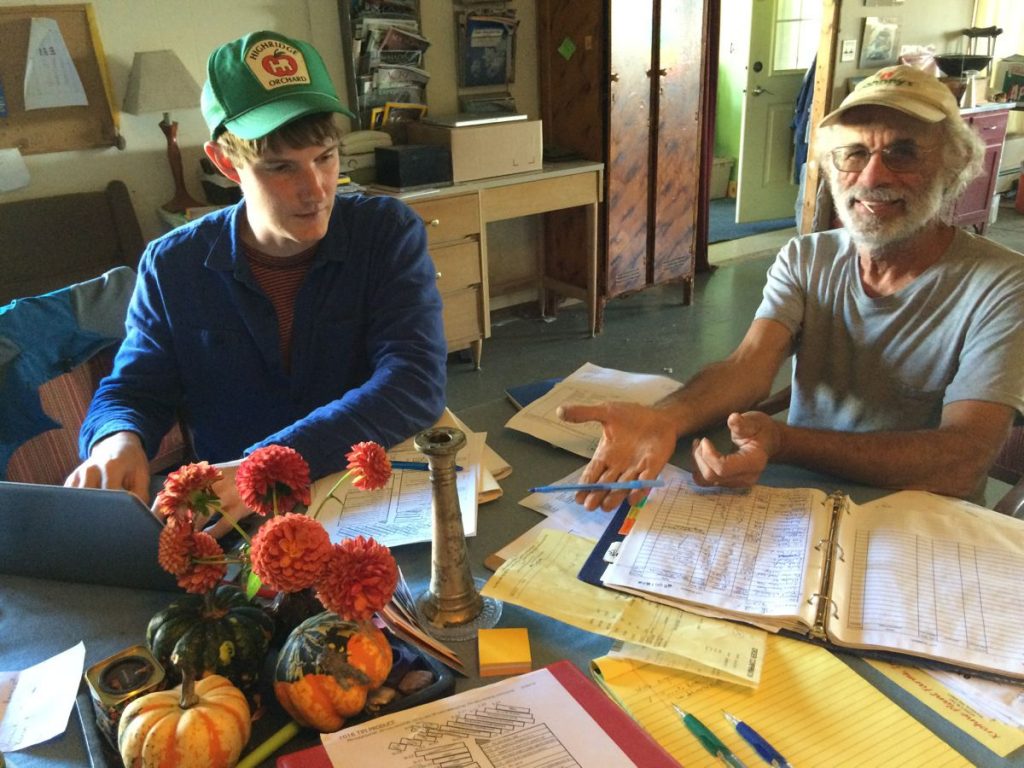
MOSA inspector Dan Marten and Steve review farm records at our kitchen table.
We had our organic inspection this week. It’s an annual step in maintaining our farm’s organic certification. Four hours of reviewing records indoors, on a beautiful sunny warm day. We passed with flying colors. The inspection is always interesting because it gives us on-the-ground insight into how other farms in Wisconsin are faring. Our inspector Dan Marten has visited vegetable farms all over the state. He reports it was a difficult season in most regions. Most got too much rain but some didn’t get enough. Like he said, “We didn’t get many gentle, overnight rains.” Seems like everyone got pounding deluges instead.
A few more gleaning photos.
I was taken with the mud boots everyone wore to our gleaning party. Here are a few beauties. You folks are so stylish!
Veggie list and veggie notes (Oct. 13/14, 2016, week #22, purple EOW)
We paired the napa cabbage with cilantro, scallions and jalapeños because they combine well in many Asian recipes. Temperatures are predicted to swing wildly this week. You can make a warm cooked dish with half your napa cabbage, then a cold salad once temperatures hit the mid-70’s again. Roast your butternut squash with a pan of oiled carrots and onions to warm the house. Then grill your peppers outside once it warms up.
Napa cabbage
Romano beans, ~1.5 lb
Butternut squash
Frying & bell peppers, mixed colors, 6 – 7
Carrots, 2 lb
Yellow onions
Scallions, 1 bunch
Jalapeño chile (HOT), 2, green or red
Cilantro, 1 bunch
UPDATE; Garlic, 1 bulb
Some sites get Romanesco broccoli.
Some sites get broccoli.
Some sites get cauliflower (white or purple or orange).
Some sites get Yukina greens.
If your squash or Romanesco is small, we’ll toss in an extra pepper or a sweet potato.
Napa cabbage (large, pale green cabbage with crinkled leaves) – This is an interesting vegetable, useful for both fresh, raw salads and for cooking. These napa are large enough to split among several recipes. Napa’s most famous use is fermented kimchi. I like to prepare a fresh, unfermented kimchi. Same seasonings, but it’s ready to eat right away. You will be amazed at how much shredded napa cabbage shrinks when prepared this way. See here for an example, but cut the salt in half: Grilled Flank Steak with Kimchi-style Coleslaw.
Storage: Napa stores very well. Cut off wedges as needed and keep the rest covered and refrigerated, and it will keep for several weeks. Peel off the outer layer and it will be ready to use. Here are a few preparation ideas from the ‘Asparagus to Zucchini’ cookbook.
– Chop raw napa into green salads.
– Substitute napa in traditional coleslaw.
– Chinese cabbage cooks quickly. Steam 3-5 minutes, or until leaves are wilted down but remain slightly crisp.
– Substitute napa cabbage for common cabbage in recipes, but reduce the cooking time by 2 minutes.
– Napa cabbage is the main ingredient in egg rolls. Try making an egg roll mixture to eat as a cooked side dish instead of preparing time-consuming egg rolls.
Romano beans – This is the final delivery of beans for the year. Quality is very nice. The beans are big but juicy and tender. We never thought we’d have this many to send in mid-October!
Jalapeño chile, HOT (small, green or red) – These are quite hot. As usual, remove the seeds and midveins to reduce their heat.
Cilantro – Well, it has taken us forever to get cilantro in the box again. We seeded repeatedly but none of the plantings work out. Except this one.
Cauliflower – We grow cauliflower in a variety of colors; white, purple and orange.
Garlic – This batch is from our friend John Hendrickson.
Butternut squash – This is our “Metro” variety, a favorite because it cures and sweetens quickly after harvest. These are medium-sized squash, average weight ~2.0 lb.
Hint for cutting winter squash: If you want to peel or dice your butternut squash, microwave the intact squash on high for one minute. That will warm and soften the squash, making it much easier to peel or cut. I find this trick useful even when just cutting the butternut in half.
Storage: Store at room temperature. On your kitchen counter is perfect.
BUTTERNUT FLAWS
Almost all of this week’s butternut squash have flaws, another legacy of the wet weather. The flaws are small enough to either peel away or cut around. We debated whether to pack them in the CSA boxes – I don’t usually send flawed squash. However, it was a choice between composting them (and having no squash for you this week) or sending them to you to enjoy, albeit with trimming. We hope you agree. Don’t try to hold these for long. Find the flaw and cut it out before cooking. It’s more difficult to recognize after cooking. Check around the stem.
RECIPES FROM LAUREN
NAPA STUFFED CABBAGE ROLLS
Adapted from Things I Made Today
I wish I could take credit for these cabbage rolls but alas I cannot. One of my favorite Madison bloggers- Vicky from Things I Made Today– whipped these up on a tired Sunday night after an exhausting day of housework and cooking. She didn’t expect them to be anything special and boy was she wrong! Something about napa cabbage, scallions, carrots, cilantro and hoison sauce is just magical. I love this dish endlessly and know you will to!
Takes 1 hour, 20 minutes
Makes 4-6
1 cup jasmine rice
1-1/2 cups water
1/2 teaspoon Kosher salt
2 tablespoons sesame oil
4 ounces mushroom of your choice, thinly sliced
1/2 teaspoon garlic powder
1/2 teaspoon dried ginger
1 pound ground pork
2 large carrots, shredded
4 scallions, sliced
1/2 cup cilantro, roughly chopped
1/4 teaspoon red pepper flakes
1 tablespoon soy sauce
1 tablespoon rice wine vinegar
1 large head Napa cabbage, leaves separated
1/2 cup hoison sauce
2 tablespoons peanut butter
1/4 cup water
- Preheat oven to 375 degrees.
- In a medium sauce pan, combine rice, water and salt. Bring to a boil, stir and reduce heat to low. Cover and simmer for 18 minutes. Remove from heat after 18 minutes (but don’t remove the lid!) and let sit for 5 minutes.
- While the rice cooks, heat oil in a large skillet over medium heat. Add mushroom along with garlic and ginger. Saute for 10 minutes until mushrooms are tender but not mushy.
- In a large bowl, combine cooked mushrooms, pork, cooked rice, carrots, scallions, cilantro, red pepper flakes, soy sauce and rice wine vinegar. Use your hands to combine.
- Lay a cabbage leaf flat on a baking sheet. Scoop 3-6 tablespoons of mushroom mixture into middle of leaf. Roll up leaf (tucking in sides if there’s extra leaf) and then place roll, seam side down, on baking sheet. Continue with remaining leaves.
- In a small bowl, combine hoison sauce, peanut butter and water. Brush the sauce over the cabbage rolls. Bake for 35-40 minutes until pork is cooked through.
- Enjoy!
————
BBQ Butternut Squash & Pulled Pork Pizza
You don’t have to have the pulled pork if you are vegetarian. I suggest doubling the butternut squash if you decide not to do the pork.
Takes 1 hour (not including time to make pulled pork), add an additional hour if you plan to make the dough from scratch
Makes 14-inch pizza that serves 4-6
1 batch pizza dough (your favorite or use my recipe below!)
2 cups peeled and cubed butternut squash
1 tablespoon olive oil
1/2 teaspoon Kosher salt
1/4 teaspoon freshly ground black pepper
3/4 cup BBQ sauce
1 cup pulled pork (here’s one of my favorite super easy slow-cooker pulled pork recipes!)
1 red Italian fryer, seeded and diced
1 green Italian fryer, seeded and diced
1 jalapeno, seeded and diced
1/2 yellow onion, diced
2 cups smoked cheddar cheese, shredded
For the pizza dough:
1-1/2 cups warm water
2 teaspoons active yeast
2 tablespoons honey
4 cups flour
2 teaspoons Kosher salt
- If you are making the dough from scratch, begin here. If not, skip to step 2. Combine warm water (but not hot!) with yeast and honey in a small bowl or measuring cup. Whisk to combine and let sit for 5 minutes. Combine flour and salt together in a large bowl. Make a well in the center of the flour mixture and pour in water with yeast. Stir to combine but do not work the dough at all, just stir until all the ingredients are incorporated together. Let dough rest for 15 minutes. Turn out onto a well-floured counter and knead for 3-5 minutes until smooth and uniform dough forms. Grease or oil a large clean bowl. Add dough, cover with plastic wrap or a towel and let rest in a warm place for an hour or until dough has doubled in size.
- Preheat oven to 425 degrees.
- Combine butternut squash, olive oil, salt and pepper in a small bowl to evenly coat. Add to a large baking sheet and bake for 30 minutes. Once finished remove from oven and add back to small bowl. Set aside.
- Preheat oven to 525 degrees.
- Once dough is risen. Roll it out on a well-floured counter until it’s about the size of the baking sheet you used for roasting the squash. Transfer the dough to the baking sheet.
- Top dough with BBQ sauce leaving an inch border on all the edges. Add pork followed by butternut squash, peppers, onions and smoked cheddar.
- Bake for 20 minutes until the crust is golden brown and the cheese is bubbly.
————
LOCAL THYME RECIPES
Comforting Classics
Buttered Romano Beans Pignoli
Chipotle Lime Cilantro Slaw with Napa Cabbage
Butternut Squash Soup with Cider Cream
Slow Roasted Salmon on Lentils Braised with Carrots and Greens
Outside the Box Recipes
Romano Beans with Caramelized Onions
Five Spice Stir Fry with Cabbage and Carrots
Butternut Pancake
Carrot Hummus
Quick and Easy Meal
Gleaning fun
- On: October 05, 2016
 0
0
It is time to review our schedule for the rest of this season. We still have extension shares (Nov. 3/4, $30) and storage shares (Nov 17/18, $105) available for those who want to extend their CSA season. I’ll send information to register for these shares in the next few days.
– October 6/7 (this week) = green EOW
– October 13/14 = purple EOW
– October 20/21 = Final delivery for green EOW members
– October 27/28 = Final delivery for weekly and purple EOW members.
Gleaning party
Our pumpkin u-pick and gleaning party was a big success. I think it’s my favorite u-pick so far. Thank you to everyone who sent us photos! I’d like to share a collection from Katie Jarvis. Her photos capture her family’s experience as they wandered the farm.

Arrival at the farm, with empty bags and anticipation.
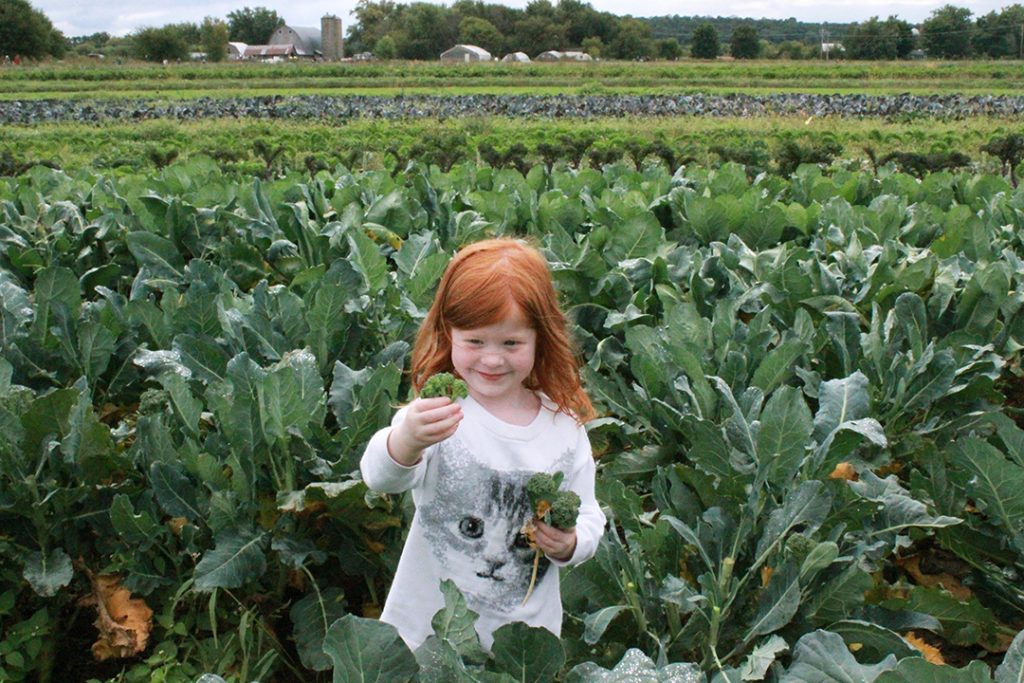
The broccoli side-shoots are the perfect size for kids.

For many children, farm puddles were the main attraction.
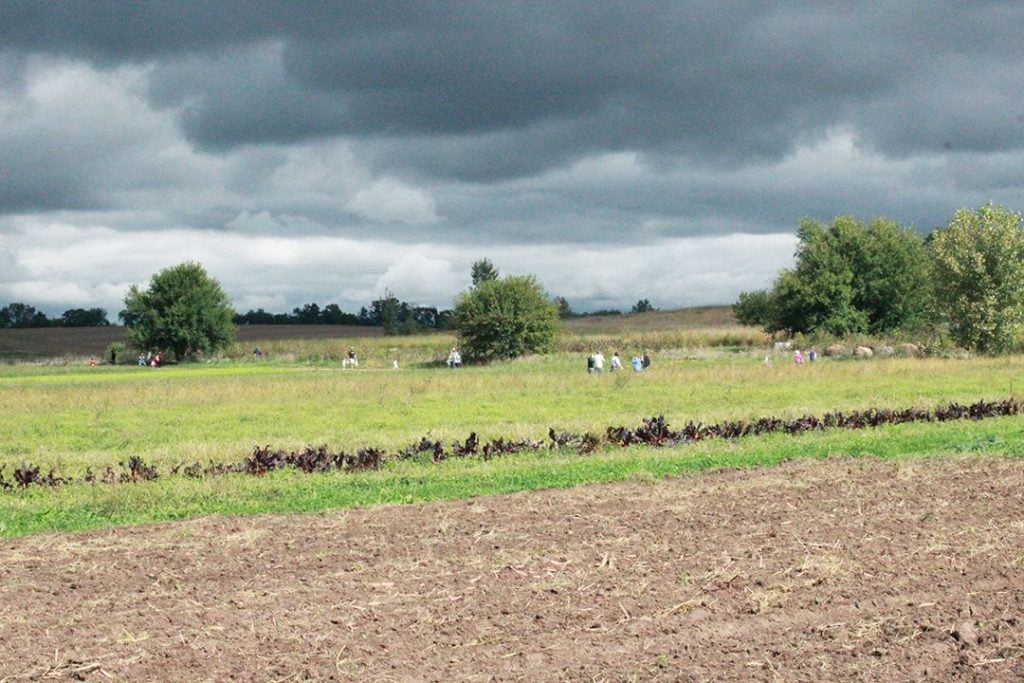
The farm is unusually green for this time of year, because of all the rain. Despite the clouds, the weather stayed dry. That felt lucky.
Julie Garret’s photos
Friend and farm advocate Julie Garret took some terrific photos. I think the overall message is that everyone found some corner of the farm to explore and enjoy.
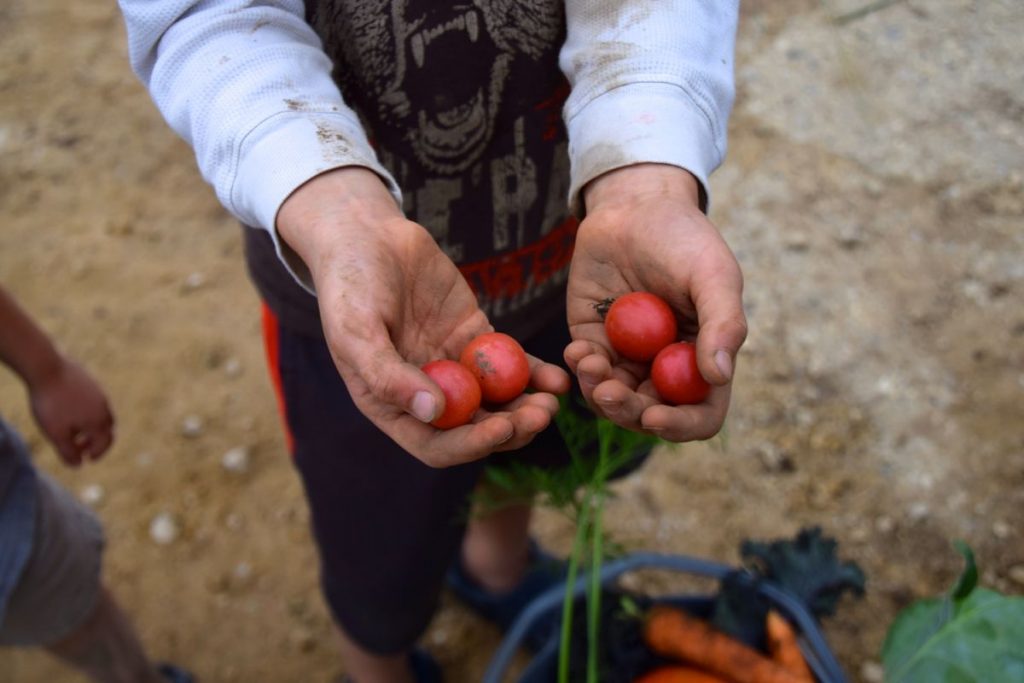
Getting dirty is part of the day.
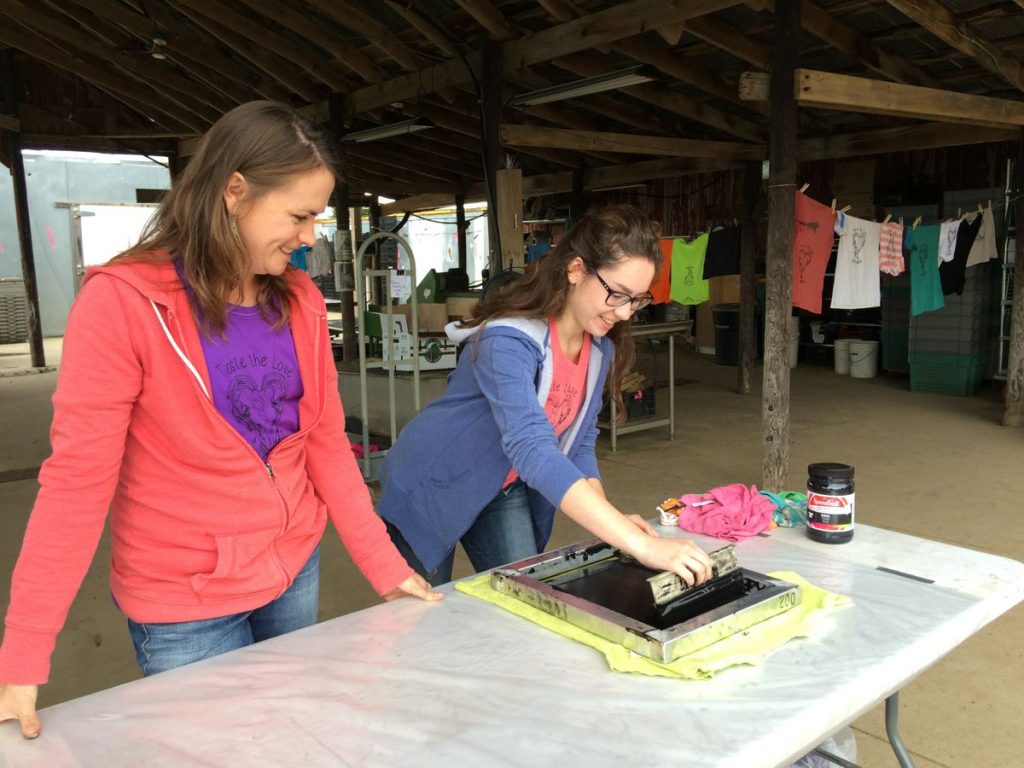
Karen and Sophie silk-screened t-shirts for everyone who brought a shirt.

Sophie’s favorite for the day!
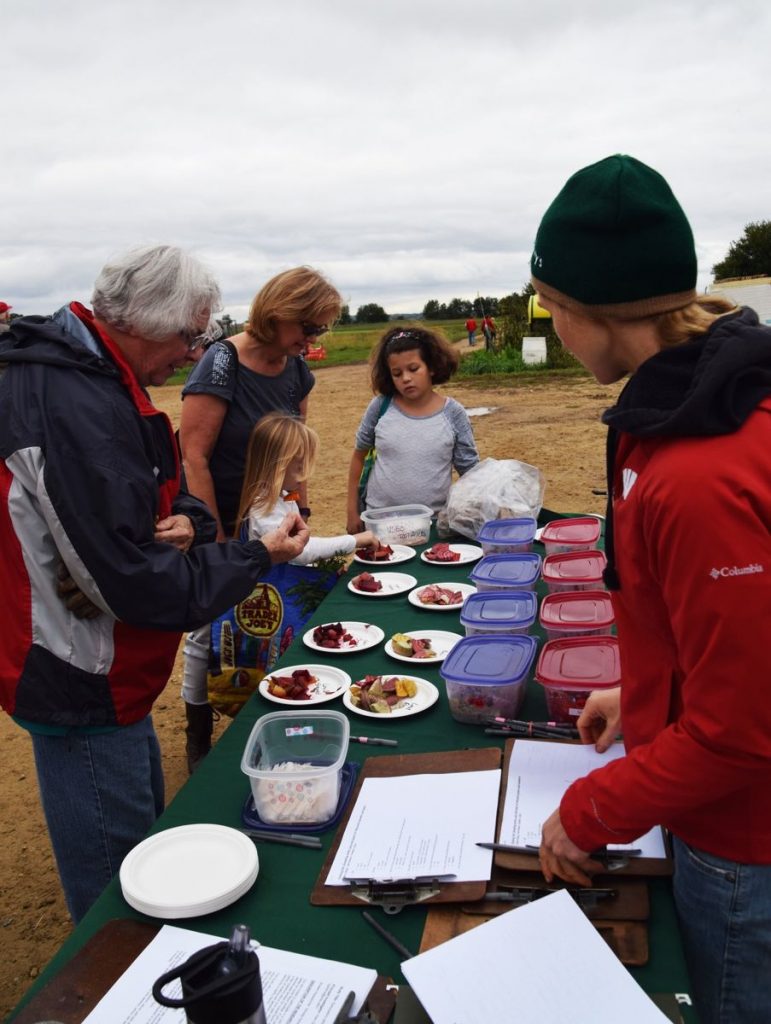
UW grad student Solveig Hanson offered beets for tasting. She collected members’ opinions about the flavor and appearance of her breeding lines. Solveig asked me to thank all of you who participated.
Veggie list and veggie notes (Oct 6/7, 2016; week#21, green EOW)
Beth’s box logic for this week:
– We timed the scallions to be ready with the bok choy, as they are a natural pairing. If you like spicy, the Anaheims will add a manageable amount of heat, color and flavor to a bok choy stir-fry.
– I also think the Anaheims will go well with the sweet potatoes. Think about oven-roasting your sweets, then topping with pan-fried onions and Anaheims spiked with vinegar or lime juice to sharpen the contrast with the sweet potatoes.
– You should get enough bell peppers for a small pan of stuffed peppers, especially if you split the peppers and stuff each half.
– We always eat our edamame directly out of the pods as a snack or appetizer. The cooked soybeans are a great addition to other dishes but (frankly) it’s easier on the cook if everyone shells their own soybeans!
– Pepper season will be over soon. Remember, you can chop and freeze peppers for use in winter.
– We start to cook beets as the weather turns cool. Steamed or roasted, we usually eat them dressed with oil, vinegar, black pepper and blue cheese. Pat has a few other ideas to offer.
Sweet potatoes, 2+ lb
Bok choy
Edamame soybeans, 1 bundle
Beets, 2 lb
Peppers, 4+, mostly green bells with something colorful mixed in.
Anaheim chiles, 2
(Note: If you find a slender green or red pepper in your box, then it is a spicy Anaheim. None of the sweet peppers this week match that description.)
Scallions, 1 bunch
Yellow onions
Some sites get broccoli.
Some sites get Romanesco broccoli.
Some sites get globe eggplant.
‘Beauregard’ sweet potatoes – Here are a few things we’ve learned about sweet potatoes:
– For best flavor, cook your sweet potatoes so they brown and caramelize. We have a simple, favorite way to roast sweet potatoes. We used to prepare sweet potato fries in the oven. Now we just quarter the potatoes, rub with olive oil, dust with salt and place cut-side-down on a cookie sheet. Roast in a 450 F oven without turning until soft. The flavors will caramelize (like sweet potato fries) but preparation is simpler and the cooking time less exacting. Slender sweet potato fries go from undercooked to overcooked in the blink of an eye. Larger slices are less exacting, and therefore are easier. Small sweet potatoes can be cut just in half. Jumbos will need to be chopped into pieces. Otherwise, they will take a long time to cook.
– Store your sweet potatoes at room temperature. They suffer chilling injury below 50 F.
– The sweet potatoes we grow require slightly longer cooking than ones from the supermarket, perhaps because they contain higher moisture so soon after harvest.
– Sweet potatoes are good at any size. We have cooked everything from tiny to jumbo and consistently find that all sizes taste good.
Bok choy (large rosette with thick white stems and green leaves) – This Asian green is good for stir-frying or sautéing or in soup. You can think of the stems and leaves as two separate vegetables. The stems require longer cooking. The leaves will cook almost as quickly as spinach. Bok choy stores well, so feel free to pull off leaves as you need them, or use the whole head at once. Refrigerate in a plastic bag.
Edamame soybeans (bundle of green stems with pods attached) – These edible soybeans are a treat. Pull the pods from the stem and wash well. It helps to submerge the pods and rub them together. Boil in water until the pods have split and the beans are quite tender. Season with salt and pop the beans out of the pods into your mouth. This Japanese specialty is becoming more and more popular in the USA.
Storage: Remove the pods from the stems promptly and refrigerate.
Bell peppers – You will get mostly green bell peppers this week. We stripped one of our three pepper fields in anticipation of a possible frost this weekend, hence the green bells. We will protect one or two fields from frost, so we should have at least a few peppers for another few weeks.
Anaheim chiles (MEDIUM HEAT, long slender peppers, red or green) – Anaheims usually have medium spiciness although it varies from pepper to pepper. As usual, the heat is concentrated in the seeds and midveins. Remove the seeds and midveins is to lessen the chili’s heat. Anaheims are easily mistaken for Italian frying peppers. We never send them in the same box for that reason. Keep this in mind if you have peppers left over from previous weeks.
Romanesco broccoli (pale green conical head, possible tinged with purple) – This is the prettiest vegetable we grow. Look at it closely to appreciate its branched beauty and repeating spiral pattern. It is called broccoli, but is closely related to cauliflower which it resembles in flavor and texture. Some of the heads have an unusual, leafy middle section. It’s harmless, just weird looking. The heads tighten up as the weather gets cooler.
Preparation: Like broccoli and cauliflower, it is fine eaten raw or cooked. It requires cooking times intermediate between the two. Don’t overcook it. I usually steam it, then dress it simply with a butter-lemon-garlic-mustard sauce.
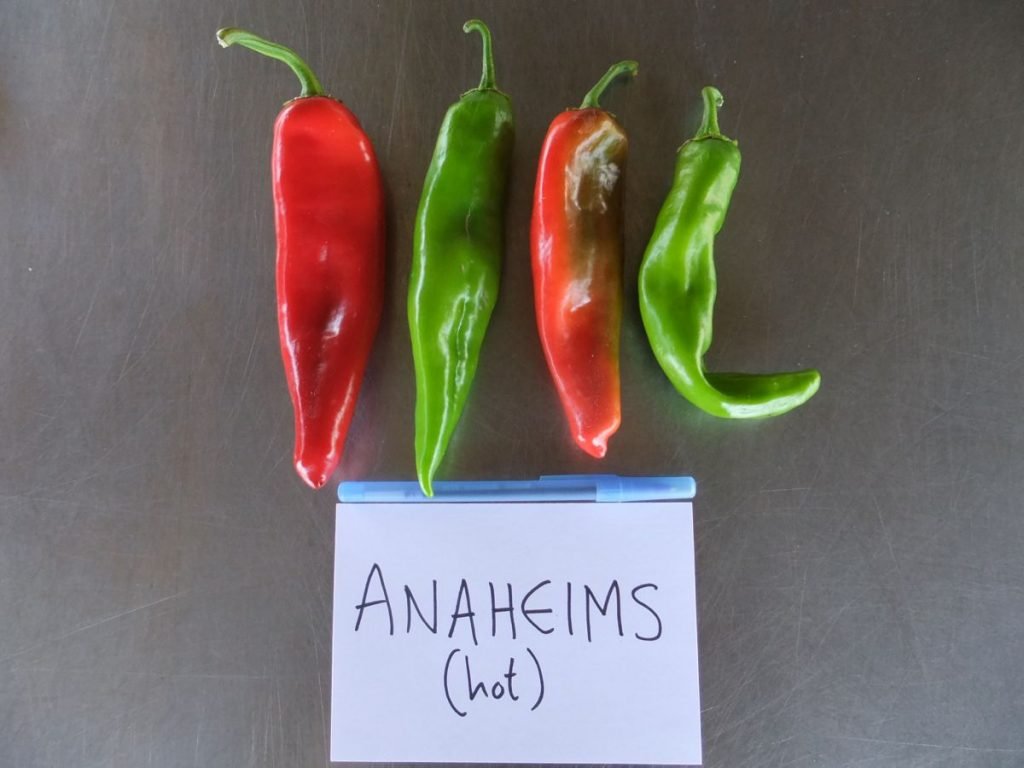
The only slender green or red peppers in your box are spicy Anaheims. None of the sweet peppers this week match that description.
RECIPES FROM LAUREN
SWEET POTATO & PEPPER CHILI
Takes 1 hour, 15 minutes
Serves 10-12
2 pounds sweet potatoes, peeled and cut into bite-size chunks
3 tablespoons olive oil
3 teaspoons cumin, divided
5 teaspoons chili powder, divided
1 tablespoon Kosher salt
1/2 teaspoon freshly ground black pepper
2 tablespoons butter
1 yellow onion, diced
1 green bell pepper, diced
1 red bell pepper, diced
2 Anaheim peppers, seeded and diced
3 tablespoons brown sugar
1 teaspoon garlic powder
16-ounce can chili (or kidney) beans
15-ounce can cannellini beans, drained and rinsed
15-ounce can black beans, drained and rinsed
28-ounce can diced tomatoes (preferably fire-roasted)
28-ounce can diced tomatoes
8 cups water
- Preheat oven to 400 degrees.
- Combine sweet potatoes with olive oil, 1 teaspoon cumin, 1 teaspoon chili powder, 1 Kosher salt and 1/2 teaspoon black pepper. Roast for 35 minutes, rotating once during baking.
- Meanwhile, in a large stock pot, melt butter over medium heat. Add onion and peppers and reduce heat to medium low. Cook for 15 minutes until well-softened.
- Add remaining cumin, chili powder and salt along with brown sugar and garlic powder. Cook for a couple minutes then add beans, tomatoes and water. Bring to a boil then reduce to a simmer and cook for 30 minutes. Add sweet potatoes to the pot whenever they finish roasting.
————
BOK CHOY SALAD WITH CASHEW SESAME CRUNCH
Adapted from Dishing Up The Dirt
Takes 30 minutes
Serves 4-6
1 bundle edamame
2 tablespoons kosher salt
1 large head bok choy
1 bunch scallions, sliced
3 tablespoons sugar
1-1/2 cups roasted salted cashews
1/4 cup sesame seeds (white or black or a combination of both)
Tahini Honey Dressing:
1/4 cup honey
1/4 cup tahini
1-1/2 tablespoon rice vinegar
2 tablespoons soy sauce
- Remove edamame pods from the stalk. Place them in a small bowl and cover with salt. Rub to make sure salt evenly coats pods. Let sit for 15 minutes.
- Meanwhile, prepare bok choy. Remove leaves from head and wash well. Pile leaves into a single stack and thinly slice them beginning at the stems.†Toss sliced bok choy and scallions in a large bowl.
- Bring a large saucepan of salted water to a boil. Add edamame and boil for 6 minutes. Drain and allow to cool while you prepare dressing.
- Add†honey, tahini, rice vinegar and soy sauce to a small bowl. Whisk until smooth.
- In a large saute pan, heat sugar over medium heat. It will slowly start to melt. As soon as it all is melted, remove from heat and stir in cashews and sesame seeds. It will begin to cool and clump together. This is perfect! Break the pieces apart with your hands if they are too big.
- Squeeze edamame out of pods with your hands into the bowl of bok choy and scallions. Toss to combine and then add dressing. Serve salad with cashew sesame crunch
————
LOCAL THYME RECIPES
Comforting Classics
Bok Choy with Scallion
Romanesco with Caper Dressing
Harvard Beets
Sweet Potato Oven Fries
Outside the Box Recipes
Chili-Glazed Salmon with Bok Choy
Steamed Broccoli with Mustard Butter
Tuna and Beet Salad with Coddled Eggs
Sweet Potato Scones with Brown Sugar Icing
Quick and Easy Meal
Box Logic
- On: September 28, 2016
 0
0
As we plan each CSA box, we look for logical combinations. I’d like to share our thought process in designing this week’s box. I think it will help you cook and enjoy the produce.
Potatoes and leeks are an obvious choice to send together so you can make potato-leek soup, or warm the house with a potato-leek casserole. Check out Lauren’s recipe below for Potato and Leek Fritters. It’s a twist on the classic combo and sounds like perfect comfort food to me.
The Zavory chiles have excellent flavor with minimal heat, and will work well with the potatoes. Parsley combines well with almost everything in the box; beans, potatoes, peppers. You may have noticed (and wondered) why we have sent so many frying peppers this year. They have consistently been the best quality peppers on the farm this season, and very delicious, so we’ve sent them multiple times.
In summer, we fill the boxes with what the farm offers. There’s a steady supply of tomatoes, peppers, melons, zucchini, sweet corn, etc. We pack a member of the onion family in every box because they are essential in cooking. Then we choose a mix of items that can be eaten raw versus cooked, to make the box easy to use. If a vegetable is unstoppable in the field (tomatoes!) then it is in every box. If it’s not (fennel) we pack it with the vegetables we think it combines best with (tomatoes, garlic).
In fall, we can be more strategic. For example, we plan to alternate starchy vegetables in the upcoming boxes, from potatoes to sweet potatoes to winter squash. Then we add at least one brassica (broccoli, Romanesco, cauliflower, cabbage) as well as some type of greens (kale, bok choy, napa cabbage) plus alliums (onions, leeks, garlic). Then we fill in with all the other special things of the season, items like scallions, celeriac, parsnips and winter radishes. In summer, the boxes are driven more by volume, by the limits of what we can fit in the box. In fall, there are as many items (and as much weight) but less fluff, so the boxes are not as full and are simpler to pack.
Here’s what I plan to cook this week. The weather has cooled so we will turn on our oven and roast a pan of potatoes, onions and garlic, using our favorite (and adaptable) recipe for roasted veggies. We’ve already prepared many of our favorite pepper recipes this summer, so I plan to make a sauce with roasted peppers and onions, parsley, Zavory chiles and garlic. In a household of ‘diverse’ eaters, it helps to have a sauce on the side to enliven oven-roasted potatoes or steamed beans. Even if you dress your steamed beans in a light vinaigrette, adding roasted pepper sauce at the table is a nice boost. I’m intrigued with this roasted carrot harissa recipe, and will adapt it to extend my roasted pepper sauce.
Finally, remember you can freeze any extra peppers, whether raw or roasted. You will enjoy them this winter. Beth
Farm News
You will notice that no one is wearing mosquito nets in the photos below. The mosquitos have abated, freeing us from our net suits. We continue to work around the rainy weather. We accomplished a lot in the fields on Monday and Tuesday so we could focus on indoor jobs when it rained on Wednesday.
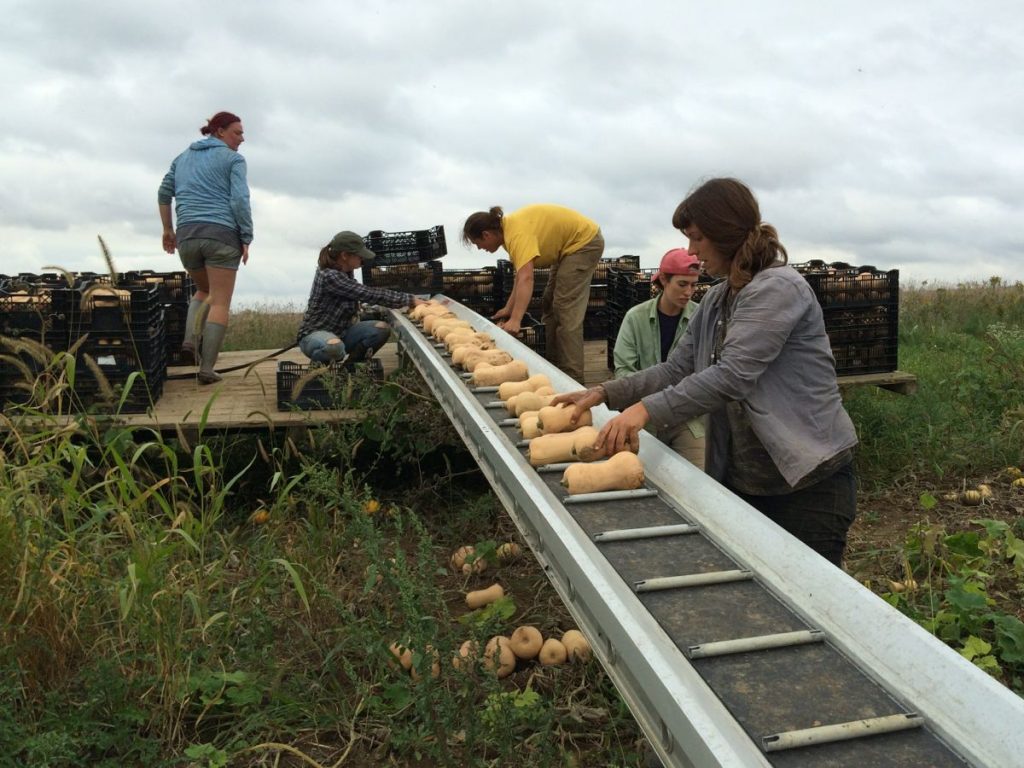
Butternut harvest is complete. From right, Charlotte and Lizzy load squash onto the harvest conveyor belt we take to the field. On the wagon, Jory, Karen and Madeleine pack and organize the squash. The butternuts are curing in our warm, dry greenhouse.
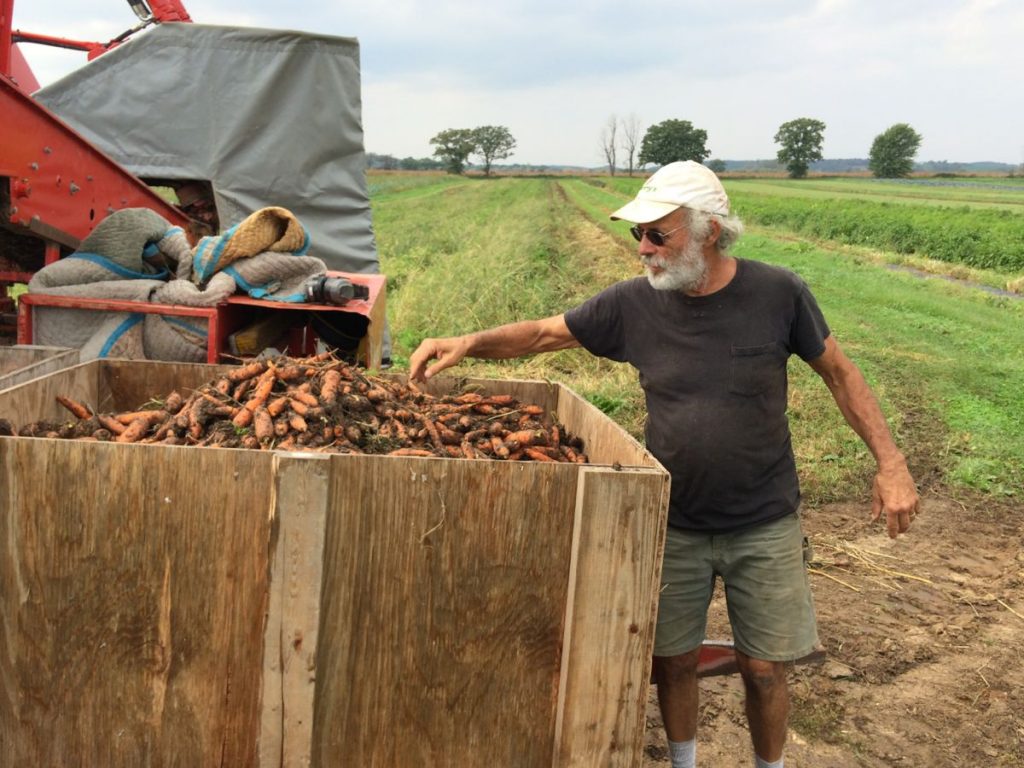
Steve, Ari and I harvested carrots during a dry spell over the weekend. Carrot harvests will continue into November.
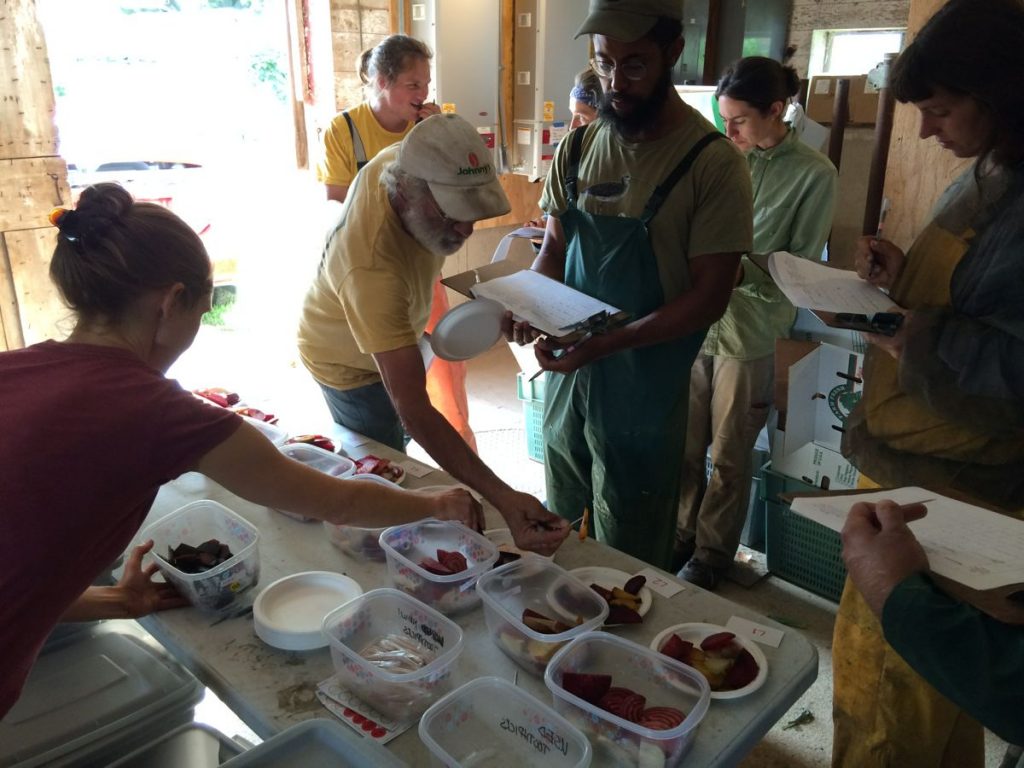
We hosted beet trials this summer for UW graduate student Solveig Hanson (at left in photo). Solveig is breeding beets for specific flavor and color profiles. She returned to the farm this week for us to sample and evaluate her breeding lines. The range of flavors is quite interesting. As a group, we are a mix of beet-lovers, beet-haters and beet-ambivalent types. Almost everyone found a breeding line they found appealing. You will have a chance to sample Solveig’s beet lines at our gleaning party. Stop by her table.
Veggie list and veggie notes (Sept. 29/30, 2016, week #20, purple EOW)
Satina yellow potatoes, 3.5 lb
Leeks, 1 lb
Broccoli, 1.25 – 1.5 lb
Romano beans, ~1.6 lb
Carrots, 2 lb
Yellow onions
A mix of peppers, mostly frying peppers, about 5 – 6
‘Zavory’ not-hot habanero chiles, a handful
Parsley, 1 bunch
Garlic (maybe?), 1 bulb
Next week’s box will probably contain sweet potatoes, bok choy, scallions, peppers, broccoli, edamame soybeans, and more.
Satina potatoes – These pale yellow potatoes are from our friends out at Driftless Organics. Satinas are an all-purpose potato with thin skin and smooth flesh. We oven-roasted a batch and they browned perfectly.
‘Zavory’ habaneros (small, orange or red) – These habaneros are NOT HOT. Almost all the spice has been bred out of them, leaving mild heat in the seeds. Now we can all learn what habaneros actually taste like. The blazing heat always got in the way, as normal habaneros are about 200,000 Scoville units. Lo-and-behold, these Zavory chiles have great, fruity flavor, really interesting. You should still approach them with caution. We’ve found rare off-types mixed in, but very infrequently, and not with the full heat of a normal habanero. As always, remove the seeds if you want to reduce the risk of spiciness.
RECIPES FROM LAUREN
MASHED POTATO & LEEK FRITTERS
Takes 1 hour
Makes 14-15 pancakes
2 pounds yellow potatoes, cubed
1-1/2 teaspoons Kosher salt, divided
2 tablespoons butter
1/2 cup whole milk
1 large leek, white and green parts only, halved lengthwise and sliced
2-3 Zavory peppers, seeded and minced
2 tablespoons minced parsley
2 eggs
1/3 cup fresh breadcrumbs or panko
1/4 teaspoon freshly ground black pepper
1 tablespoon olive oil
2 tablespoons vegetable oil
- Place potatoes and 1 teaspoon Kosher salt in a large pot. Cover with water and bring to a boil over high heat. Once boiling for 15 minutes, drain water and mash potatoes. Stir in butter and milk until thick and creamy. Add additional milk if needed to thin. Measure out 1-1/2 cups for the fritters. Save the rest for another use.
- Combine mashed potatoes, leeks, peppers, parsley, eggs, breadcrumbs, remaining salt and ground pepper in a large bowl. Stir until smooth. The mixture will be loose and wet, but this is just fine!
- Heat oils in a large skillet over medium-high heat until very hot but not smoking. Drop spoonfuls of the potato mixture into the hot pan in two tablespoons piles being careful not to crowd the fritters. Flip once browned (2-3 minutes) and then press down with a spatula to flatten. Remove from the pan once both sides are browned and gently move to a paper towel. They will still be quite delicate. Keep the first batch in the oven at 200 degrees if you like while you prepare the rest.
- Serve warm with sour cream and some additional chopped parsley.
———-
COLORFUL BROCCOLI SALAD
Takes 15 minutes
Makes 6 cups
1 large head broccoli
1/2 cup buttermilk
1/3 cup mayonnaise
2 tablespoons cider vinegar
1 tablespoon sugar
2 red frying peppers, diced
1/2 yellow onion, diced
1/3 cup dried cranberries
Kosher salt and freshly ground black pepper
- Bring a large pot of water to a boil over high heat.
- To prepare the broccoli, cut off the florets and roughly chop into bite-size pieces. Take the broccoli stems and cut into small matchsticks.
- Once the water is boiling, add just the broccoli florets (not the stems) and blanche for 3 minutes then strain and rinse under cold water.
- Combine buttermilk, mayonnaise, cider vinegar, and sugar in a large bowl. Whisk until smooth. Add broccoli, broccoli stems, peppers, yellow onions and cranberries to bowl and stir with a spatula until dressing coats salad.
- Season with salt and pepper.
———-
LOCAL THYME RECIPES
Comforting Classics
Broccoli Almondine
Buttered Romano Beans with Leeks
Italian Rice Stuffed Peppers
Pot Roast or Portabello Pot Roast
Outside the Box Recipes
Roasted Broccoli Persillade
Romano Bean, Potato and Meatball Stew
Sweet Italian Pepper Sauce with Capellini
Carolina Cabbage and Carrot Slaw
Quick and Easy Meal

